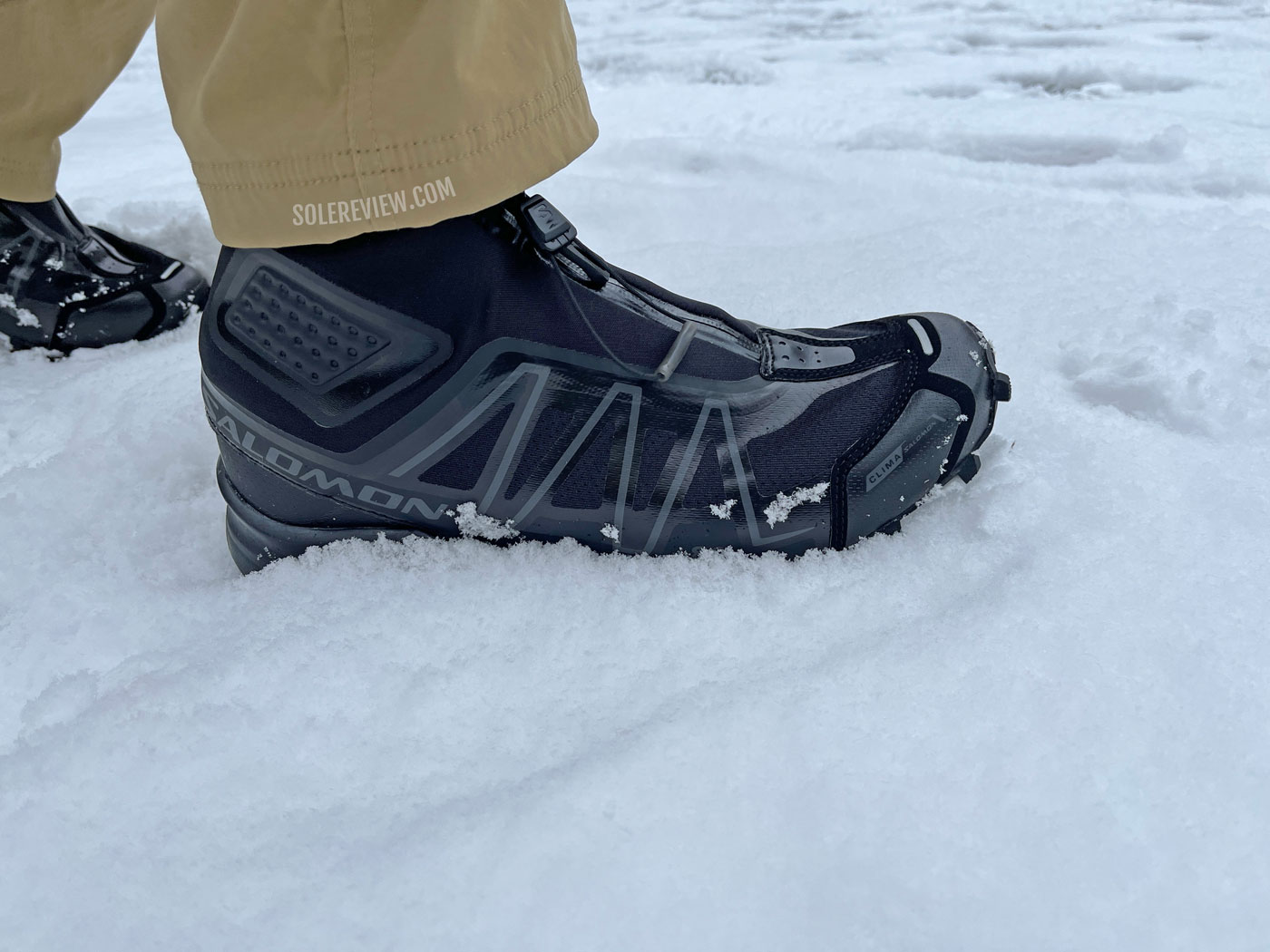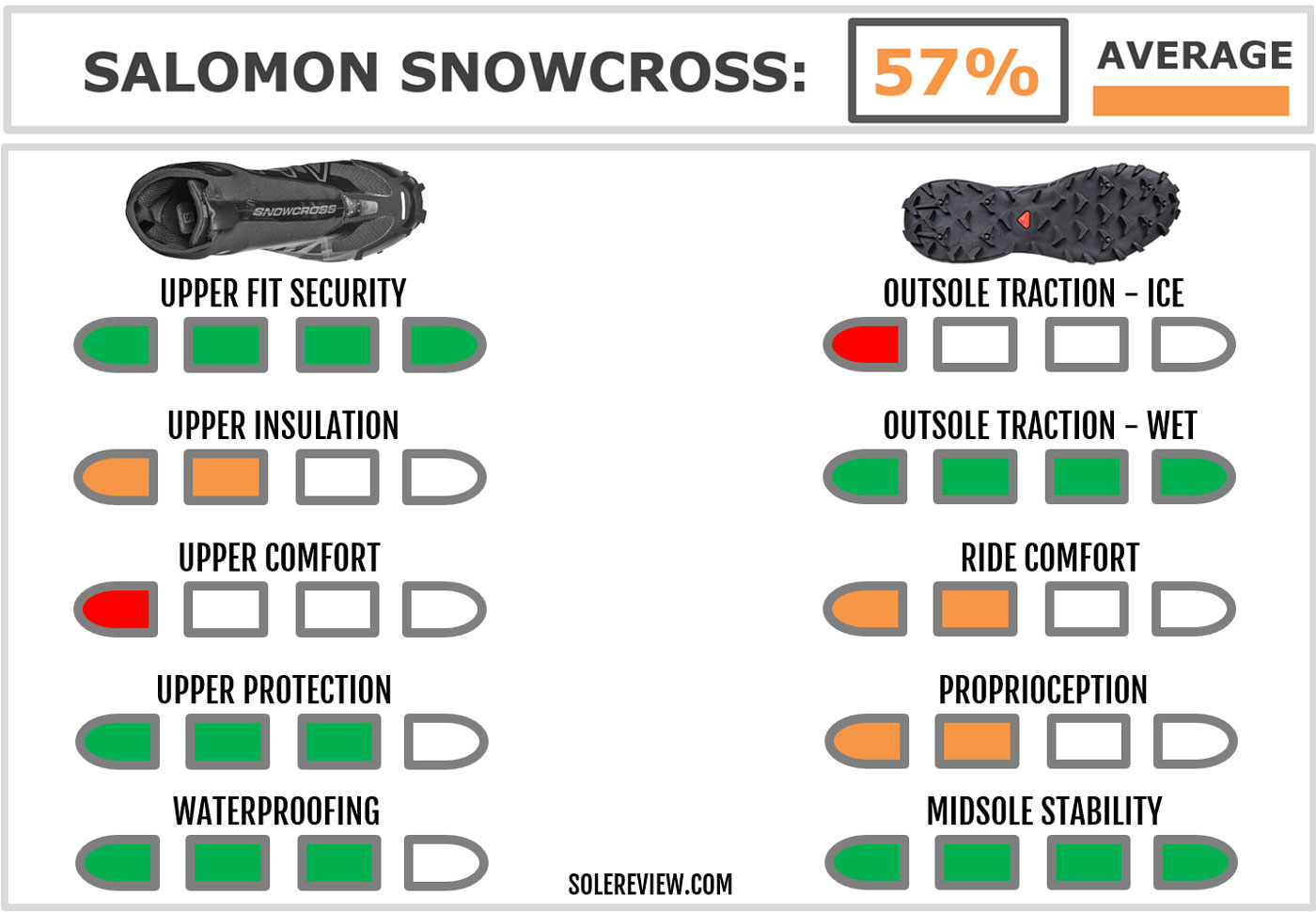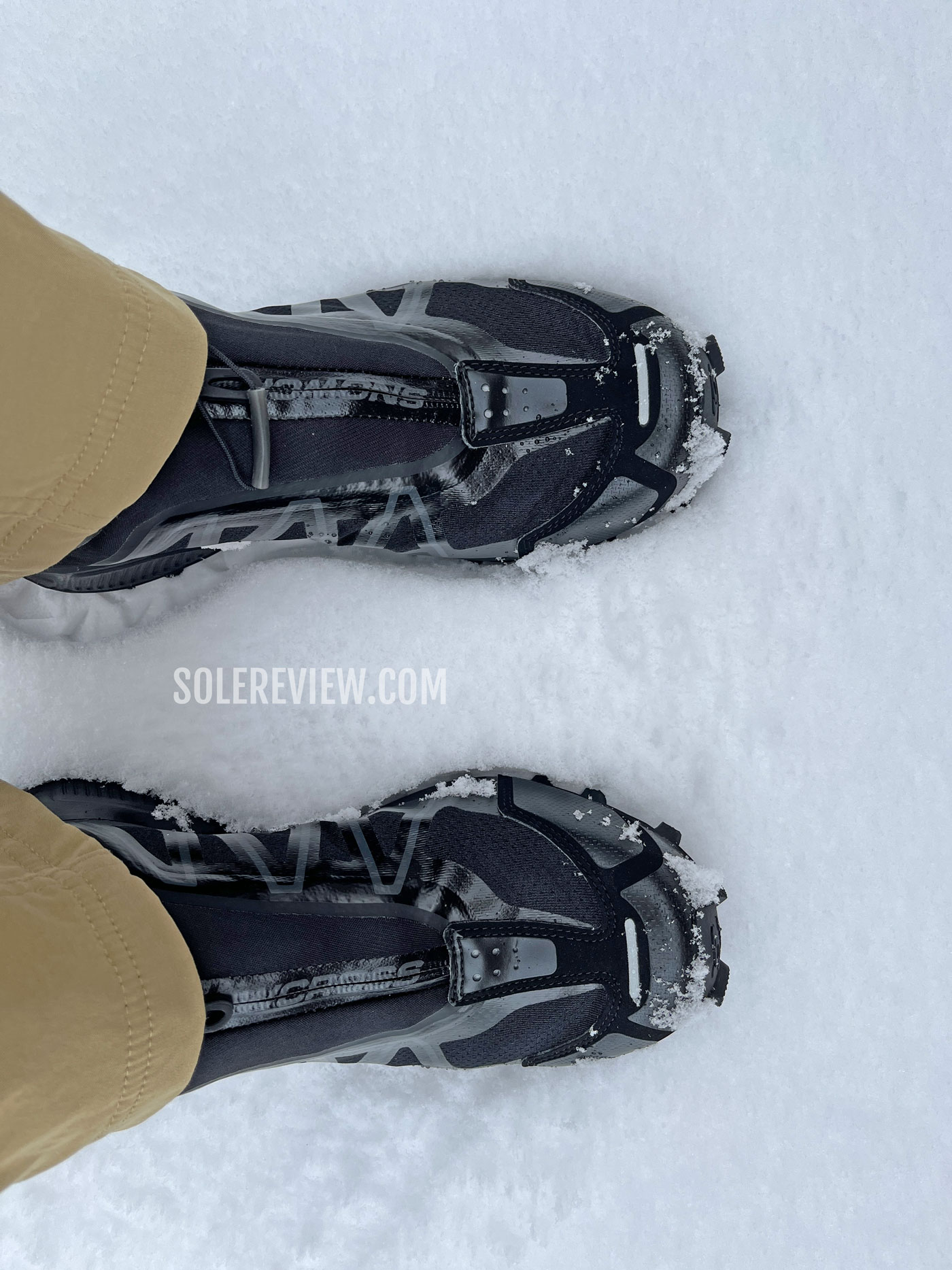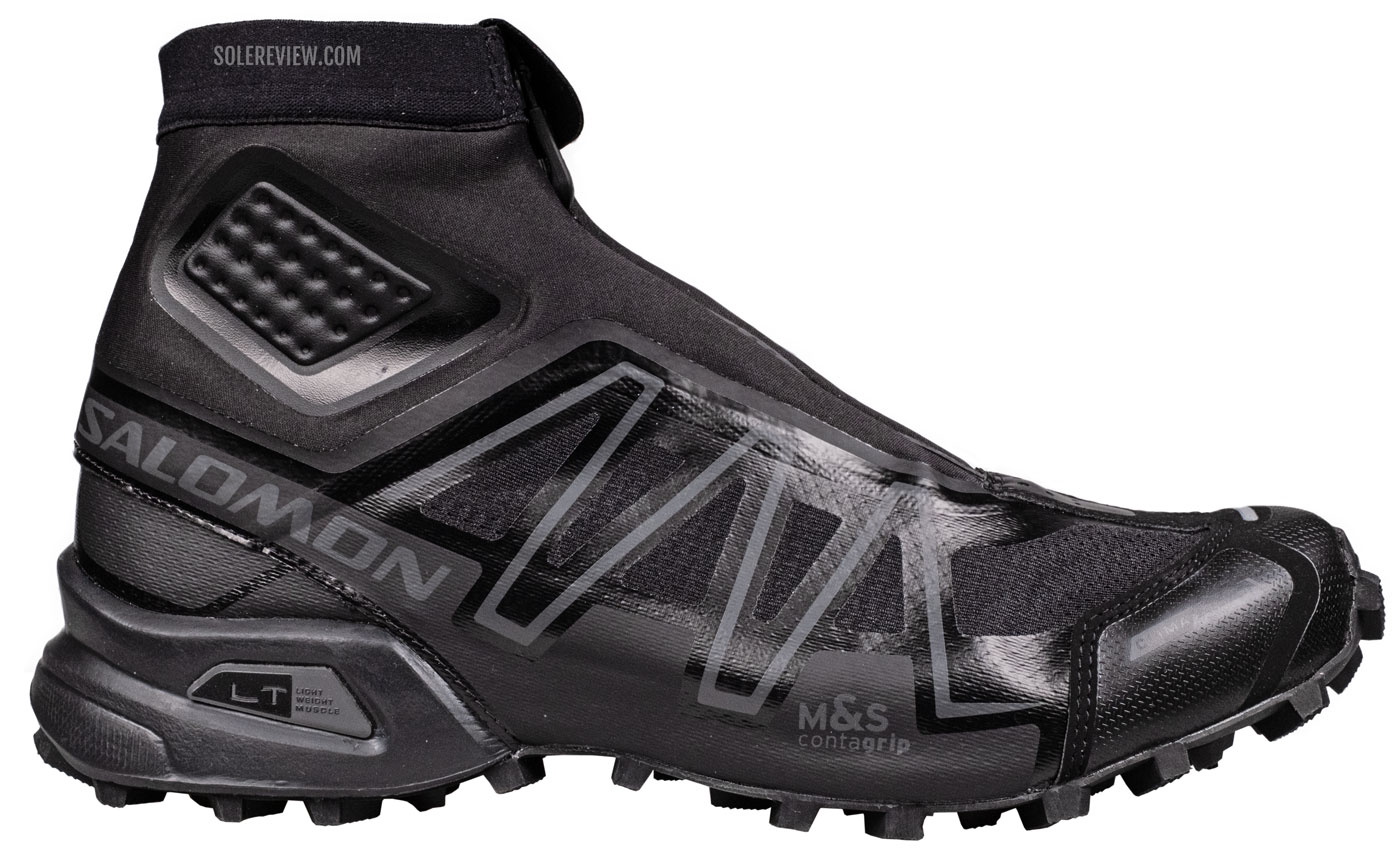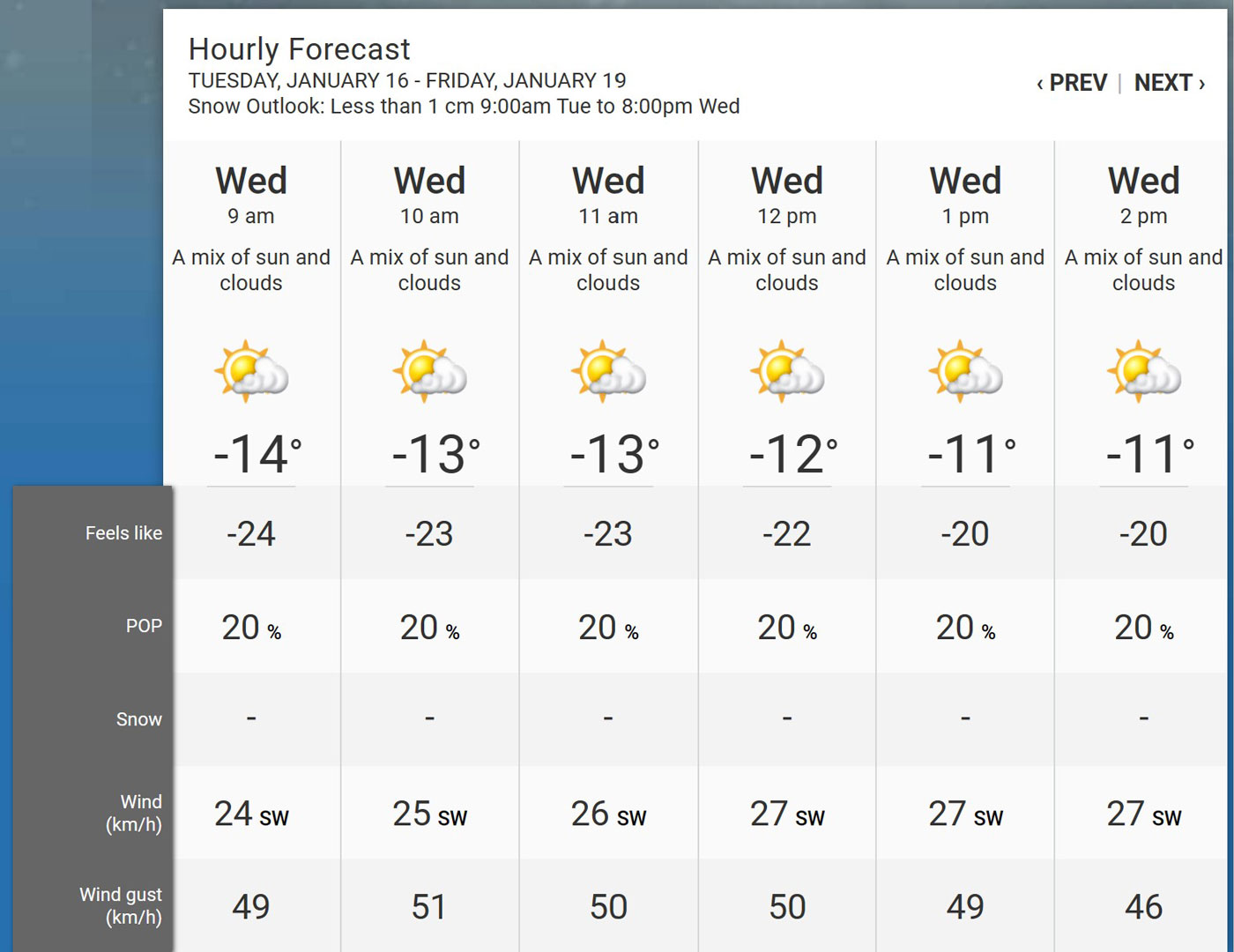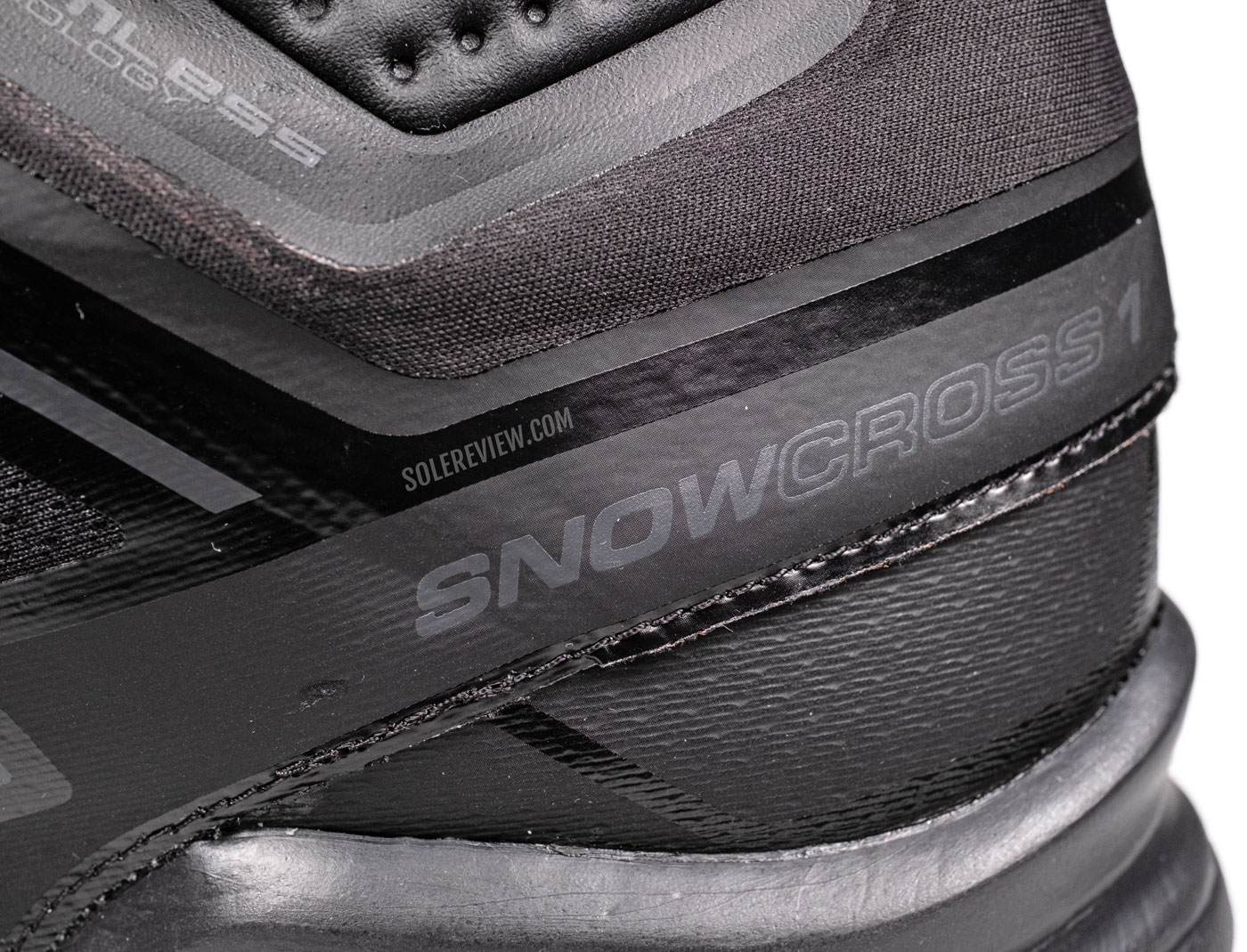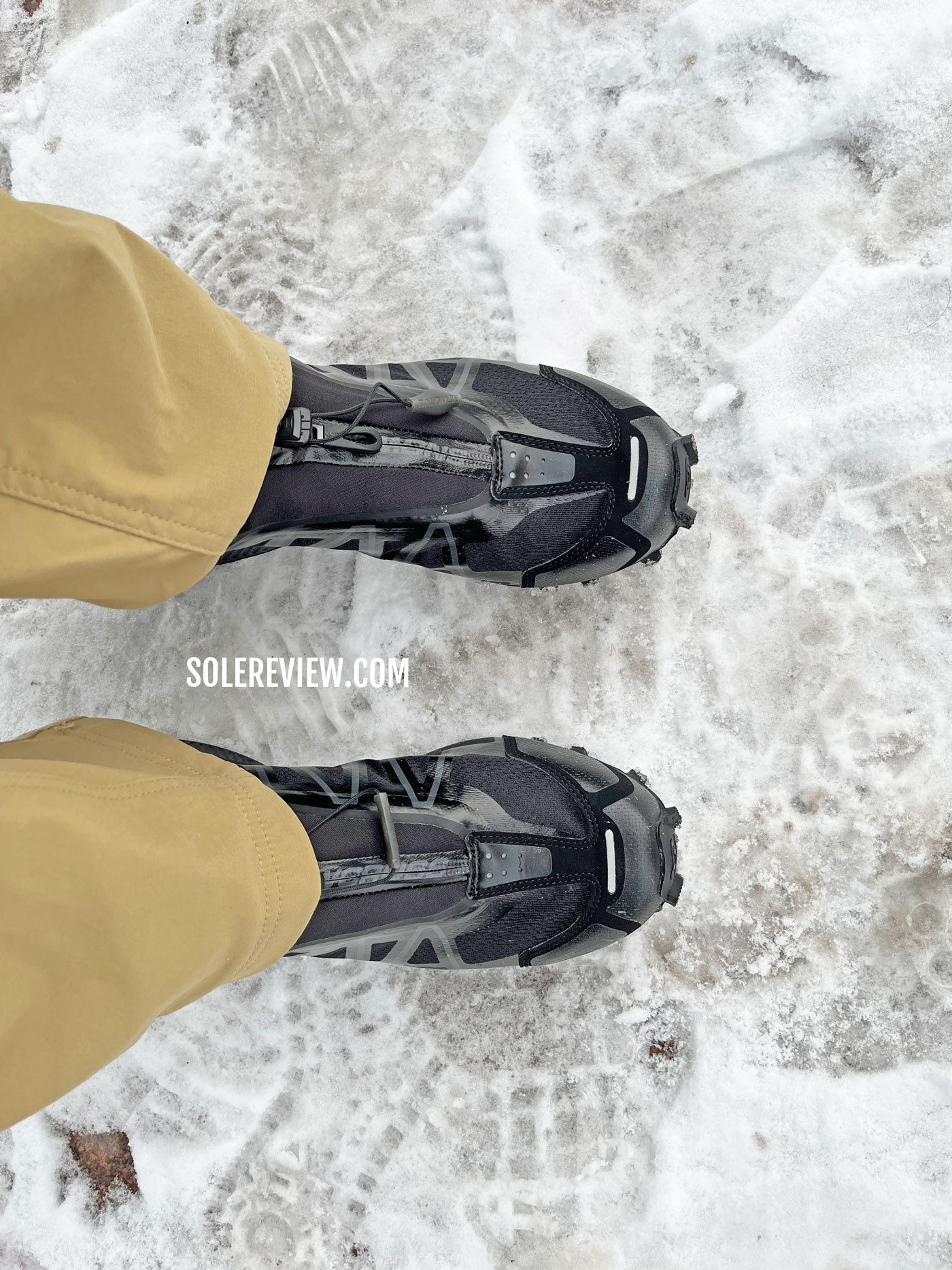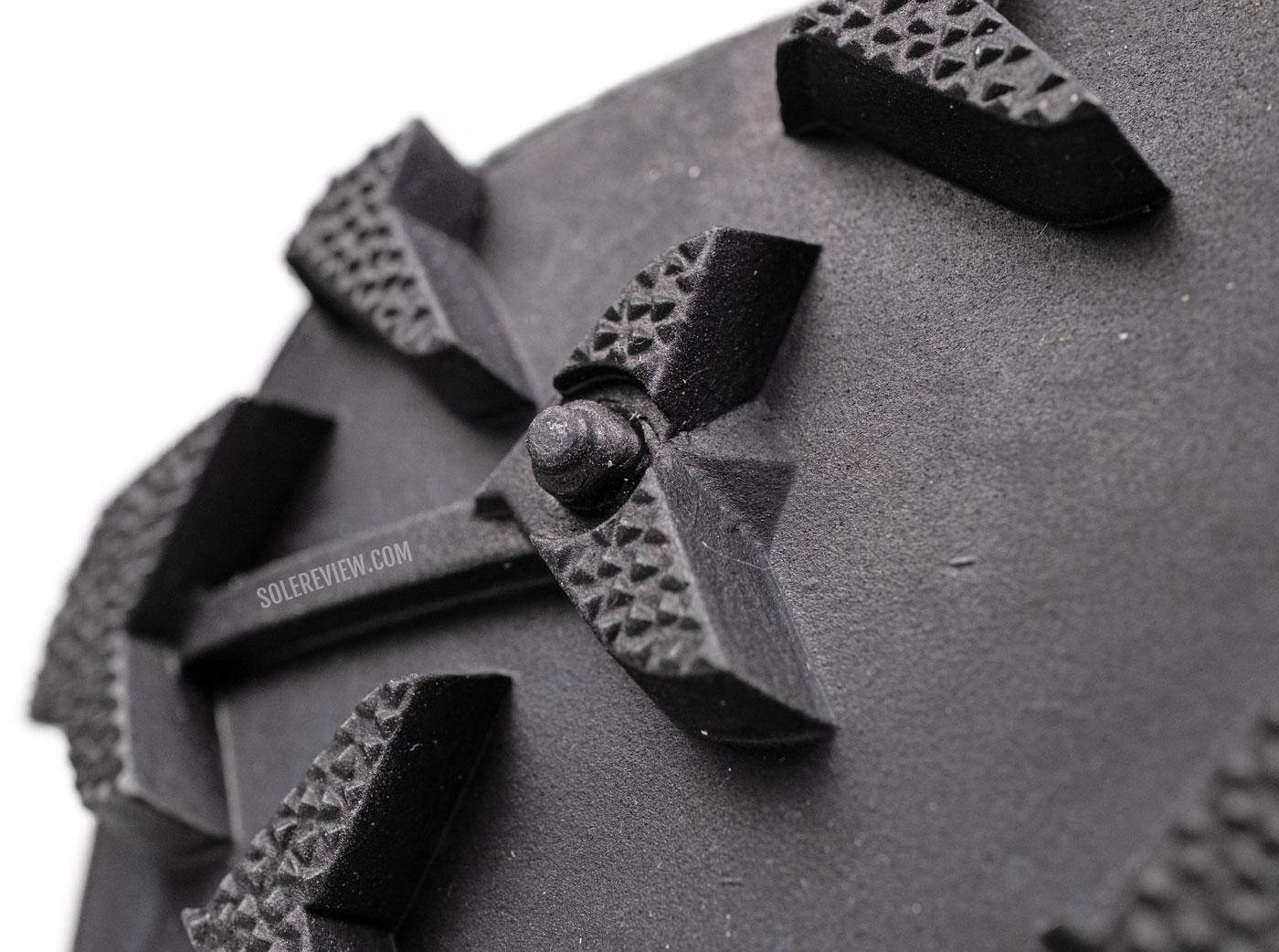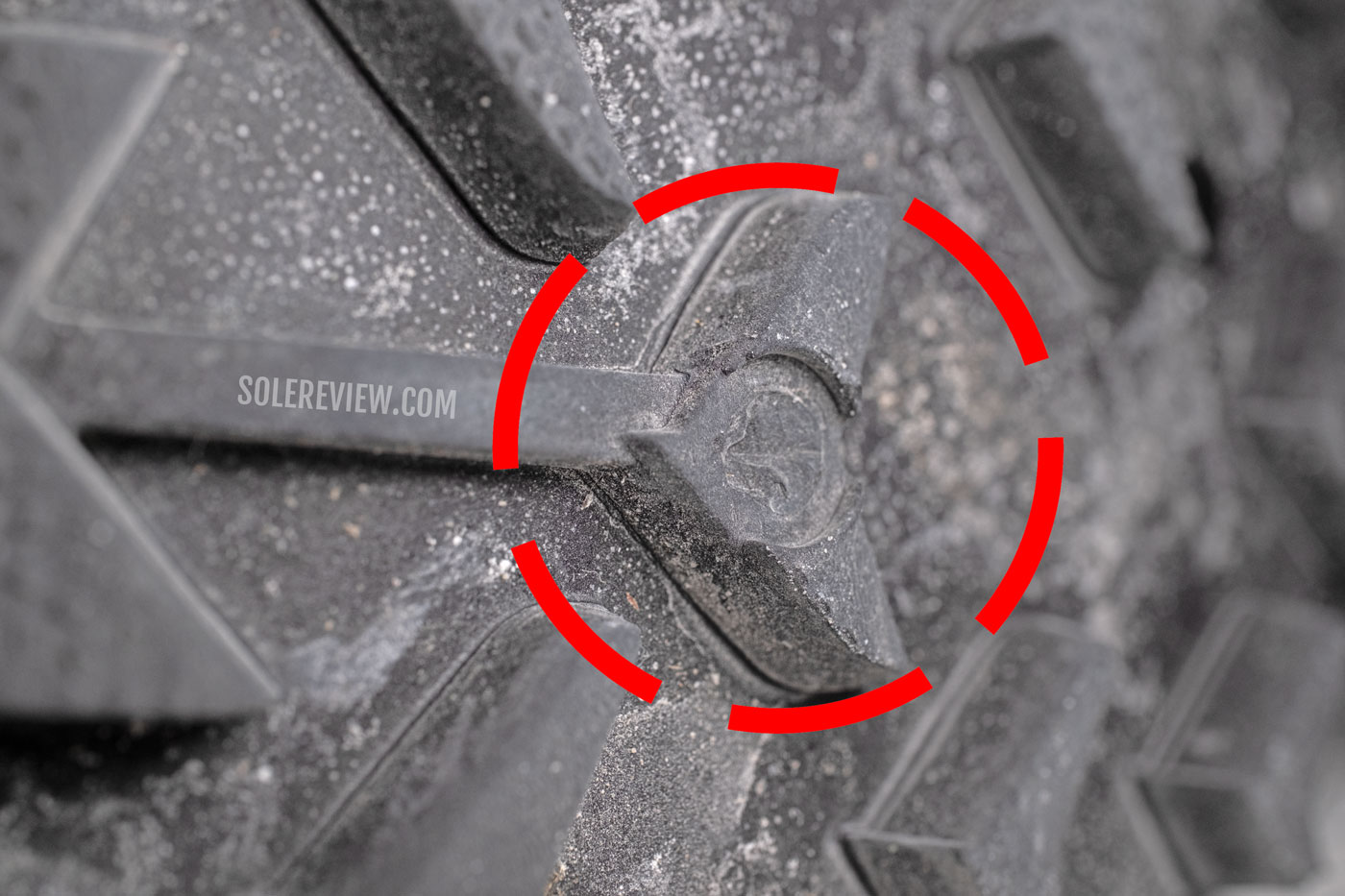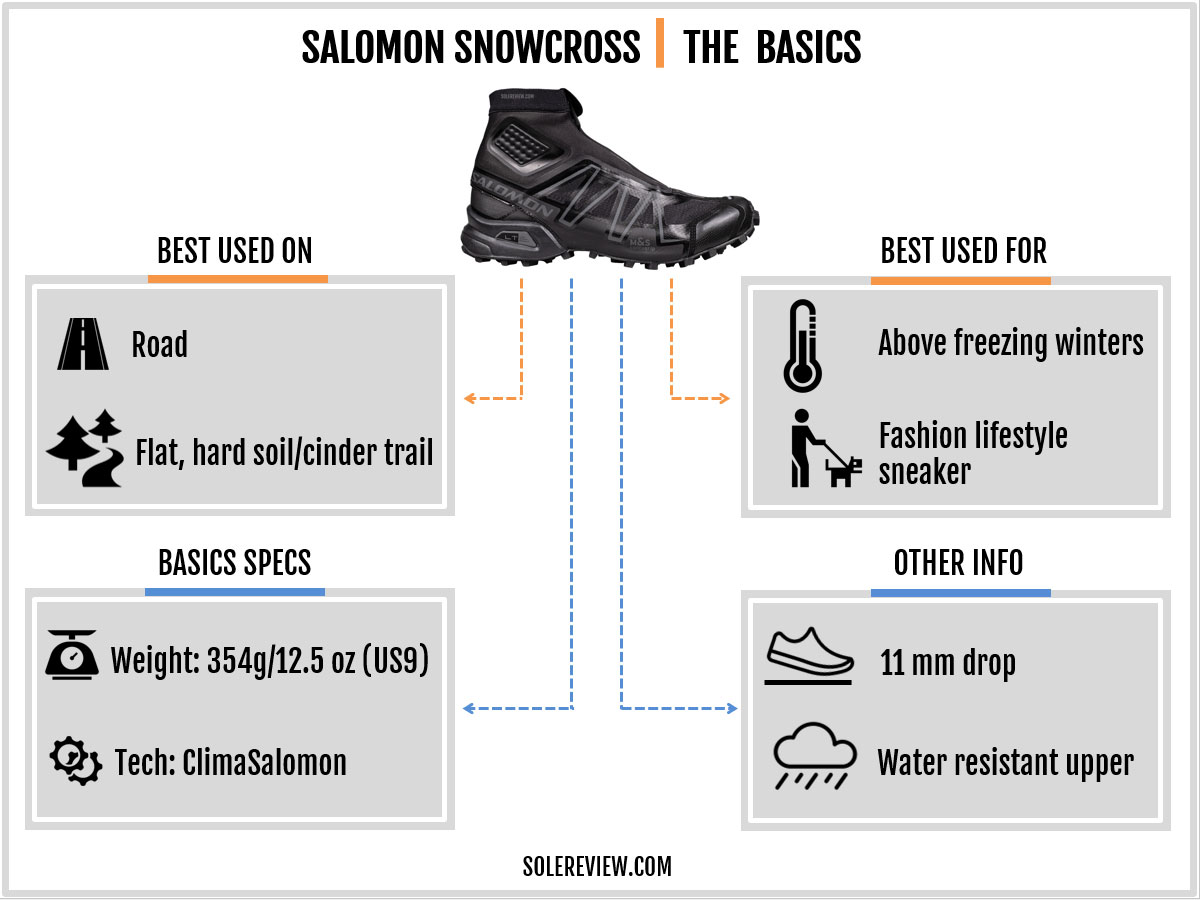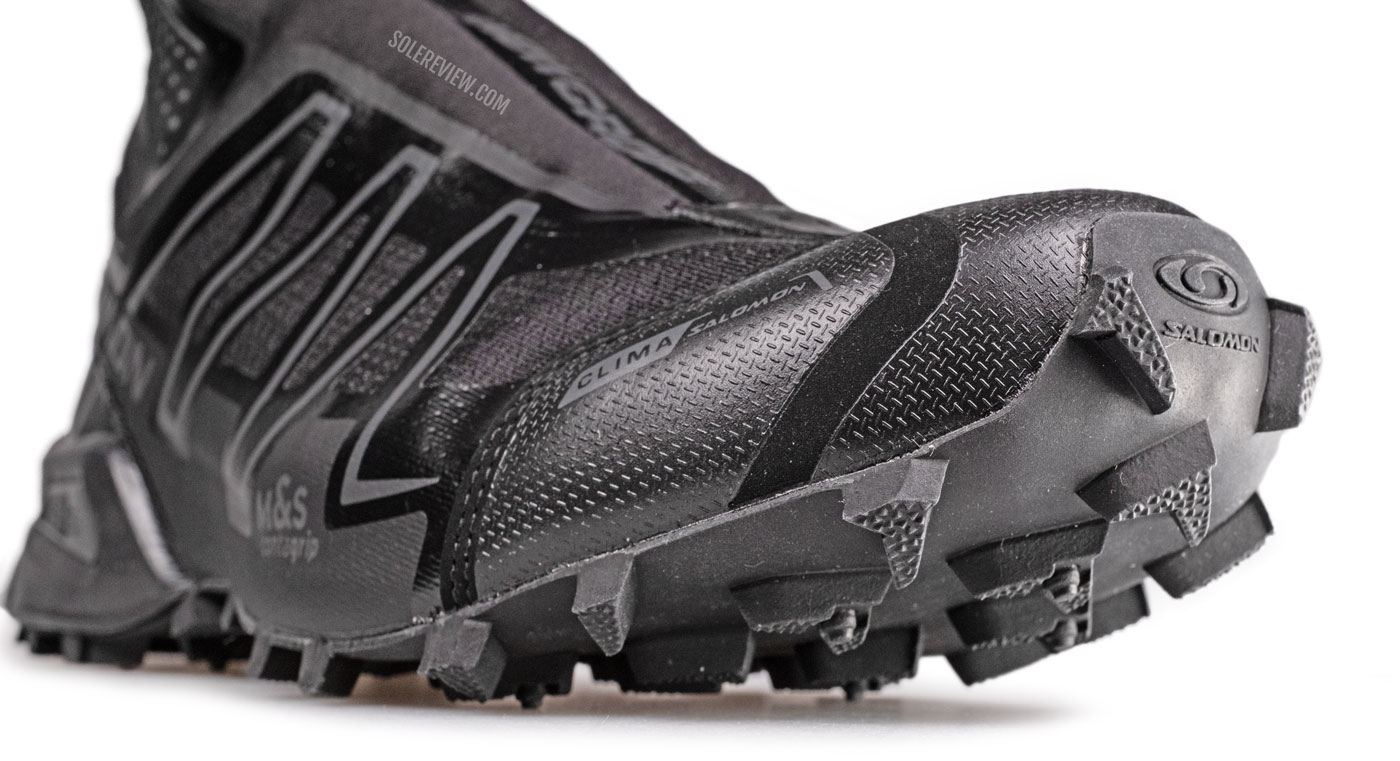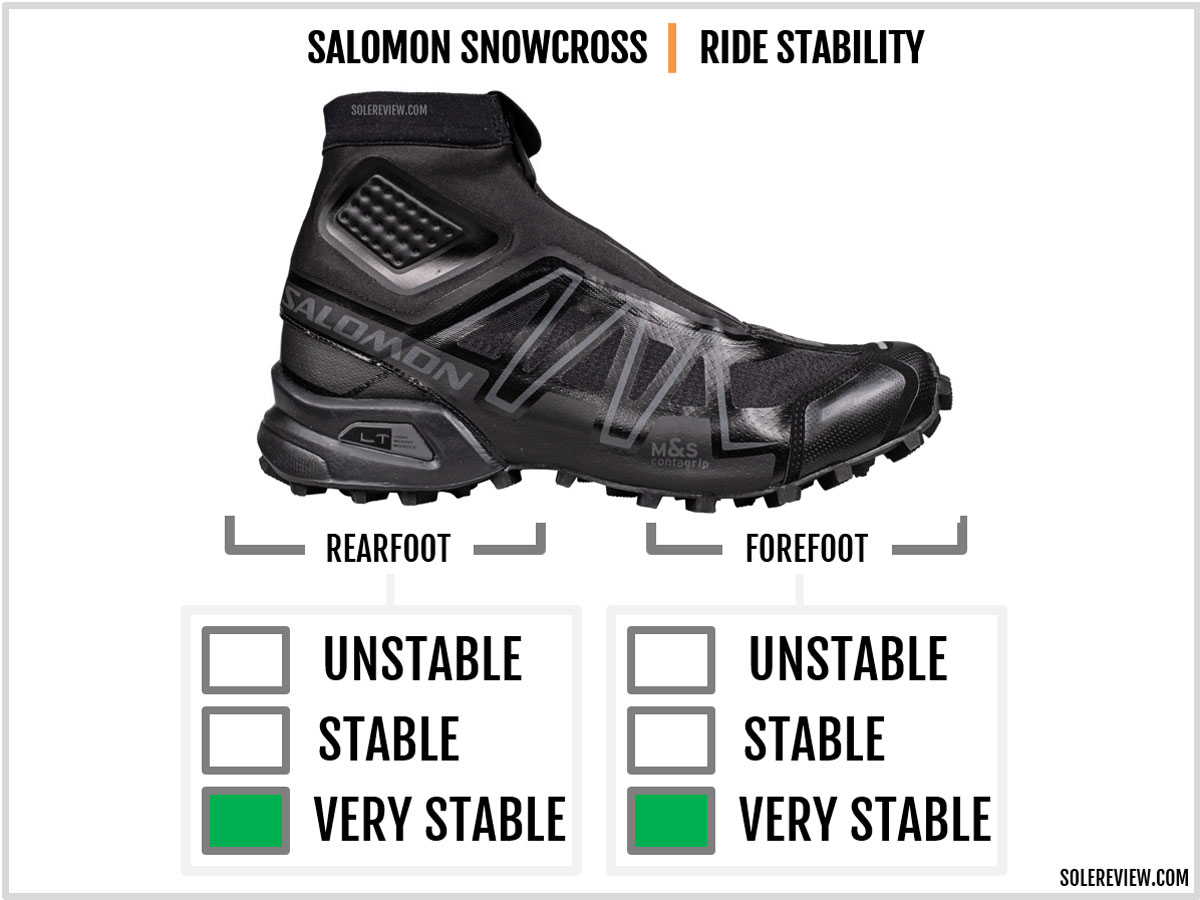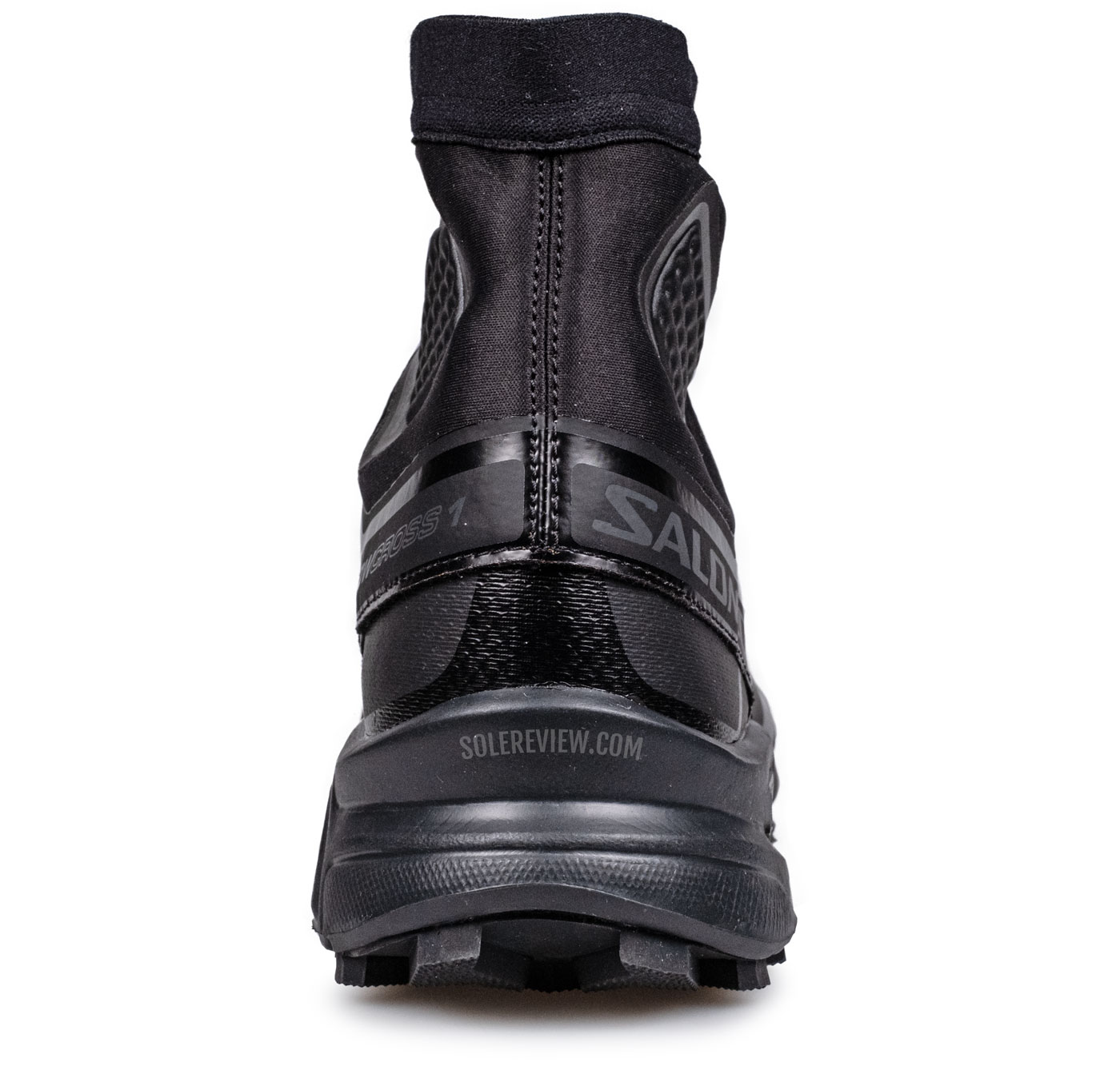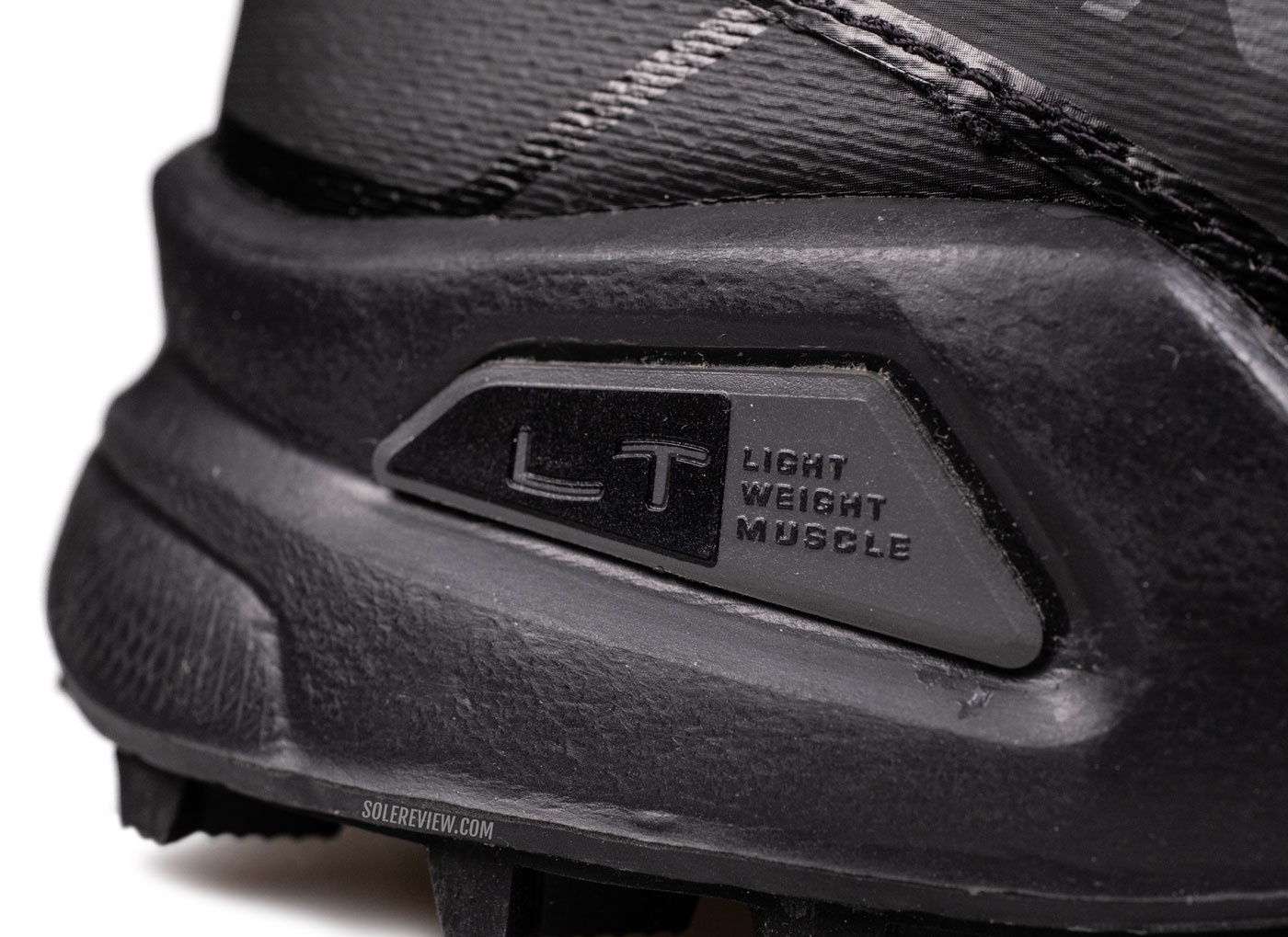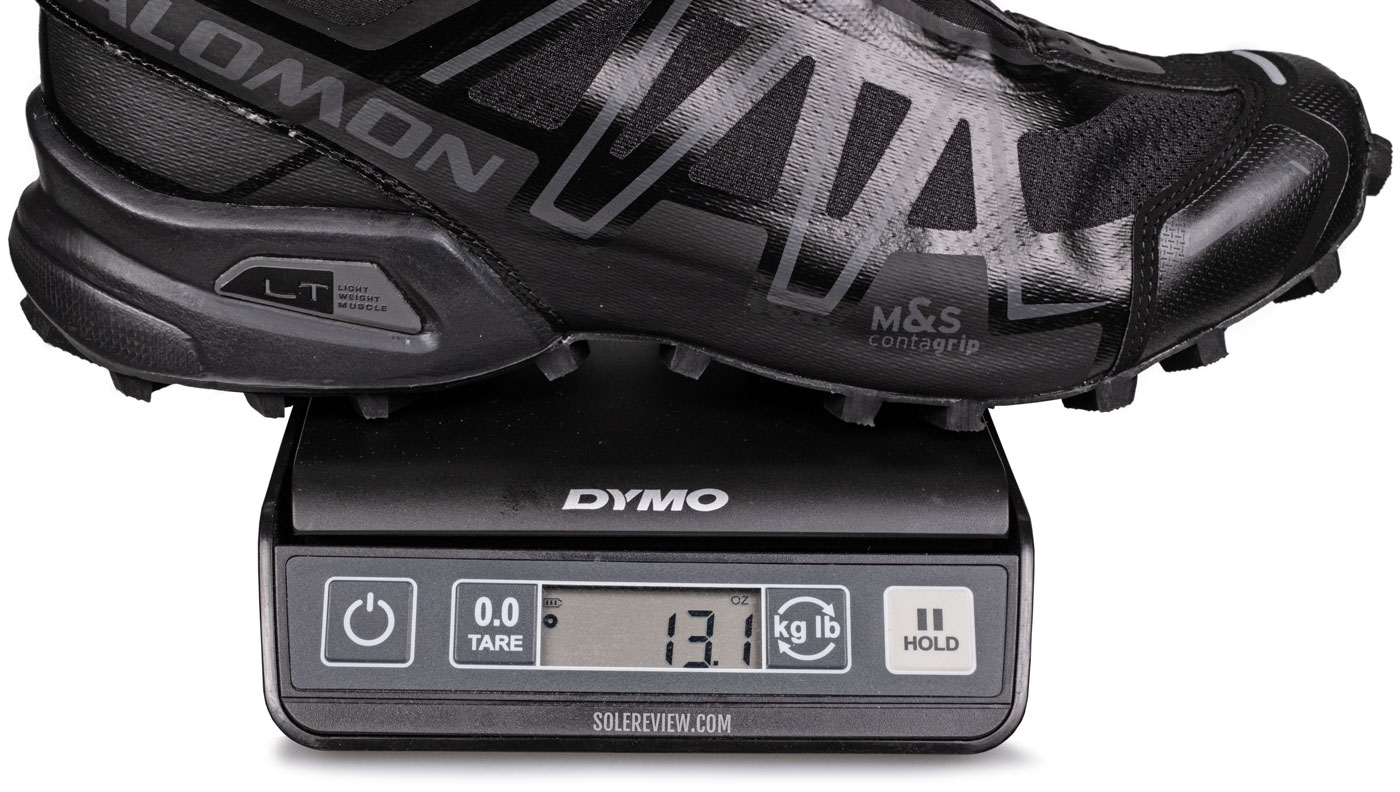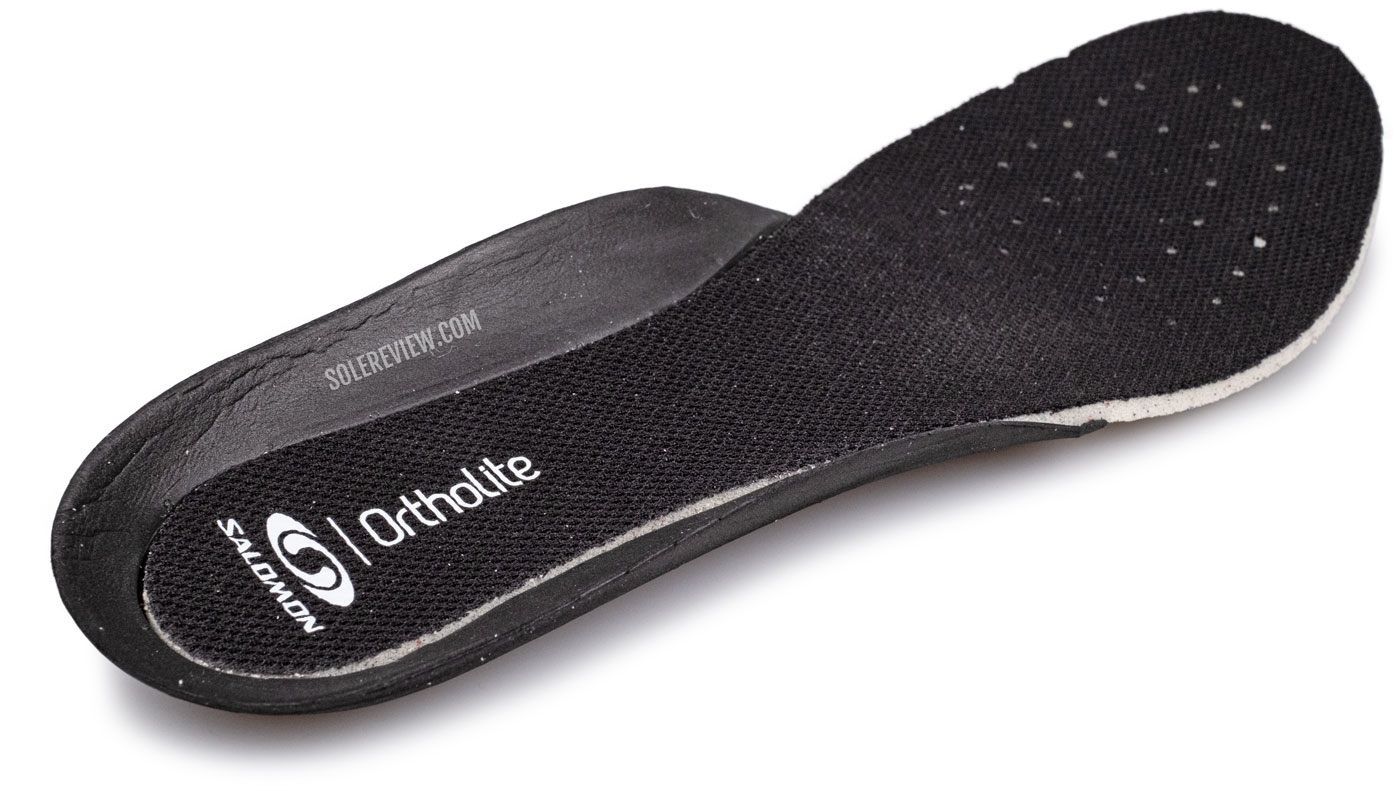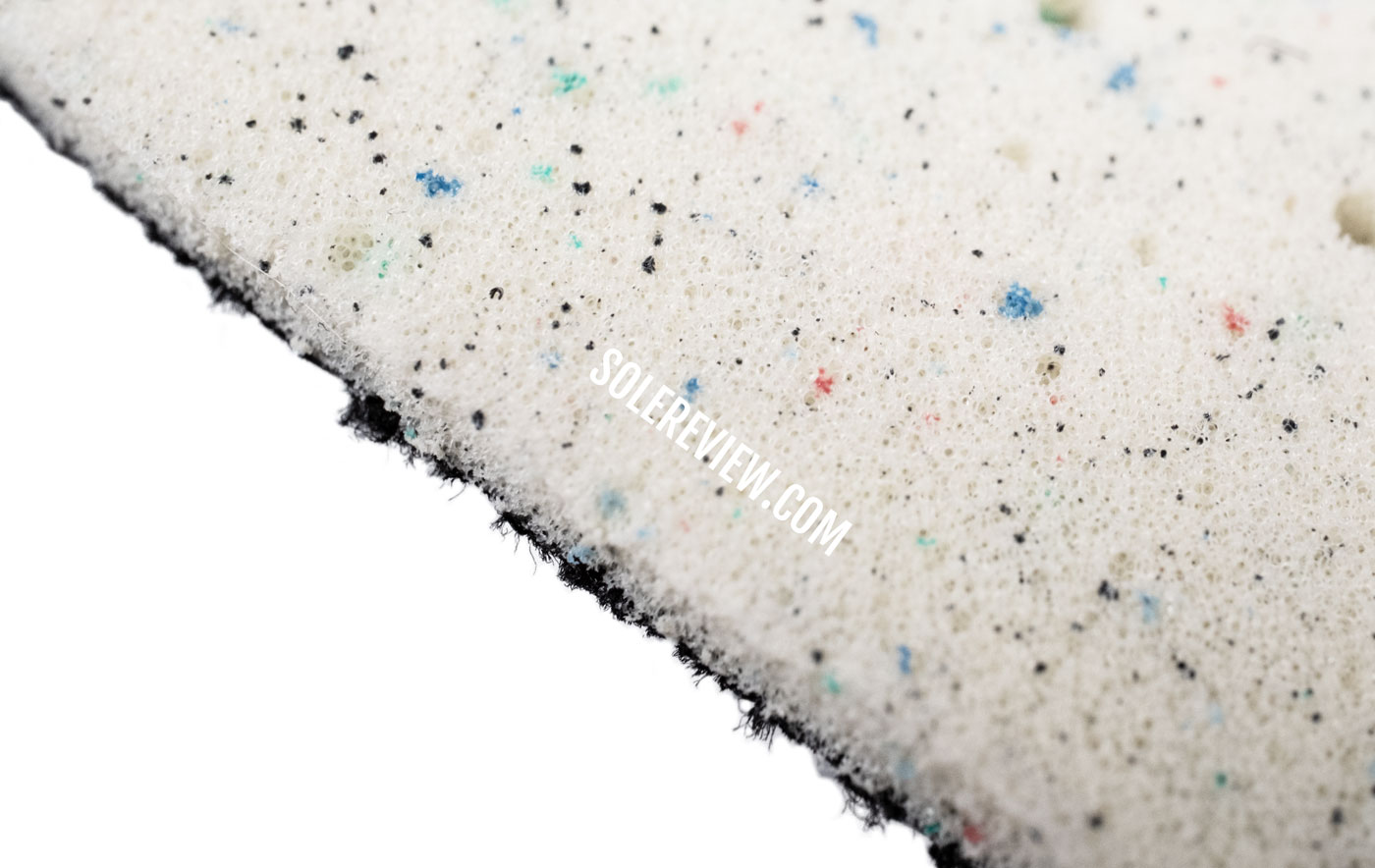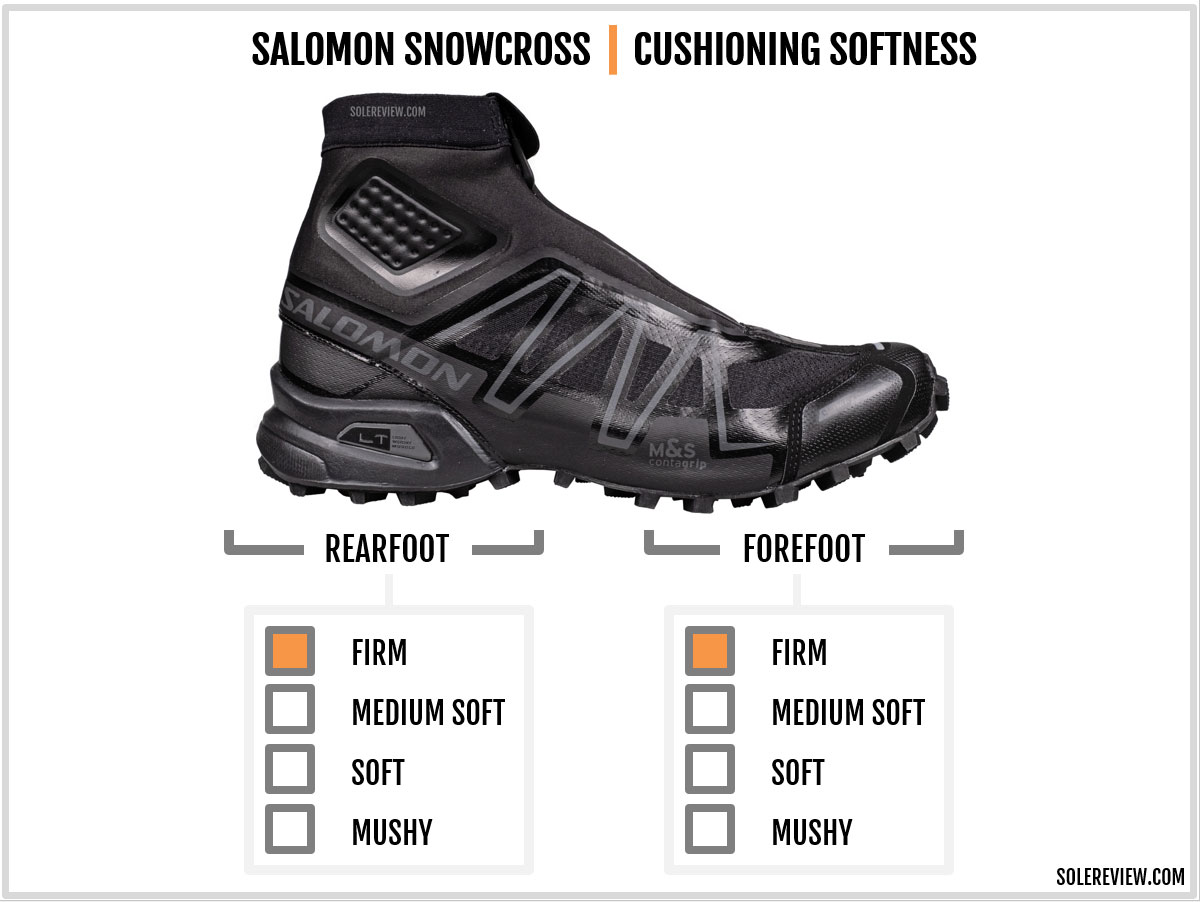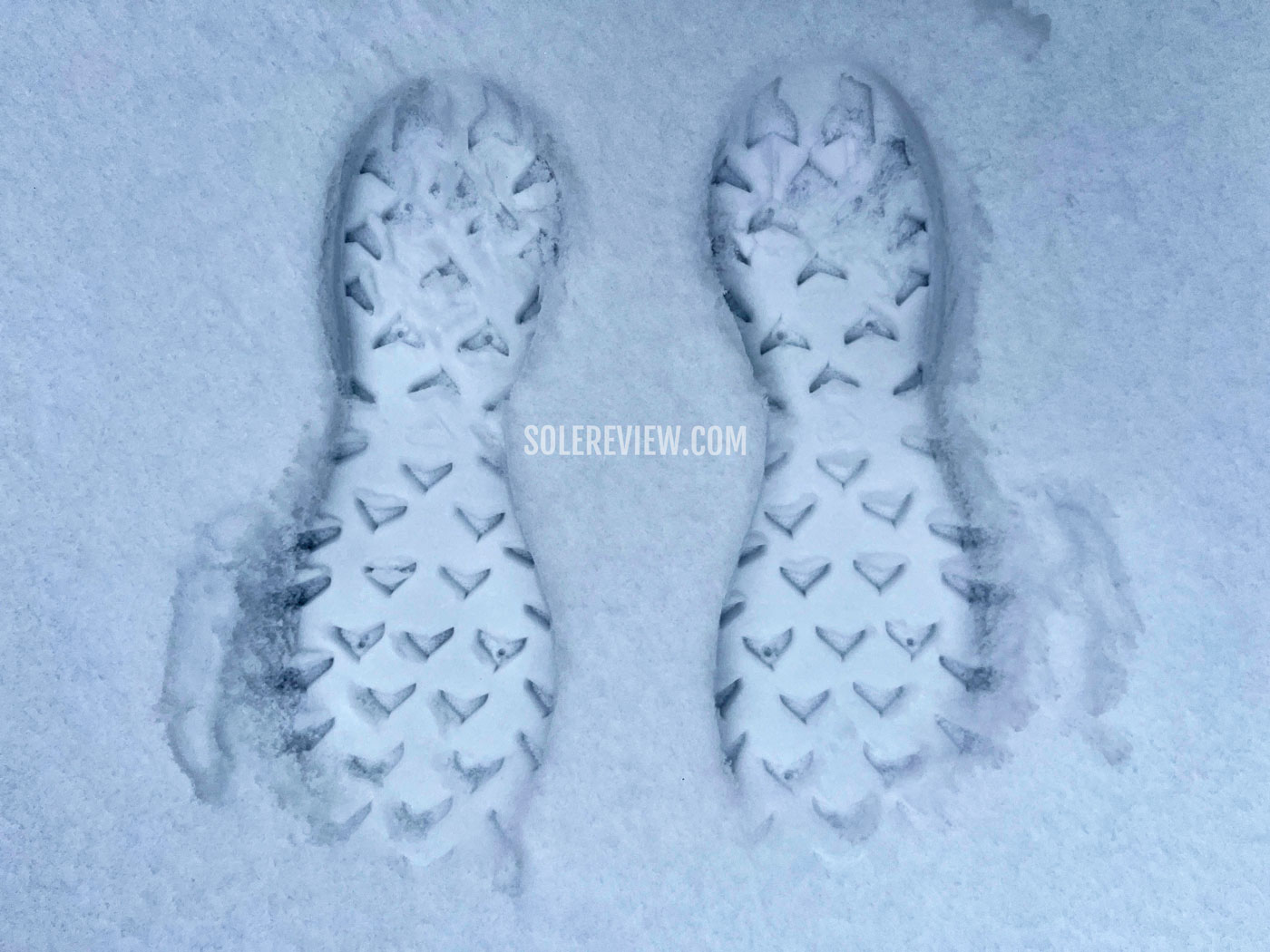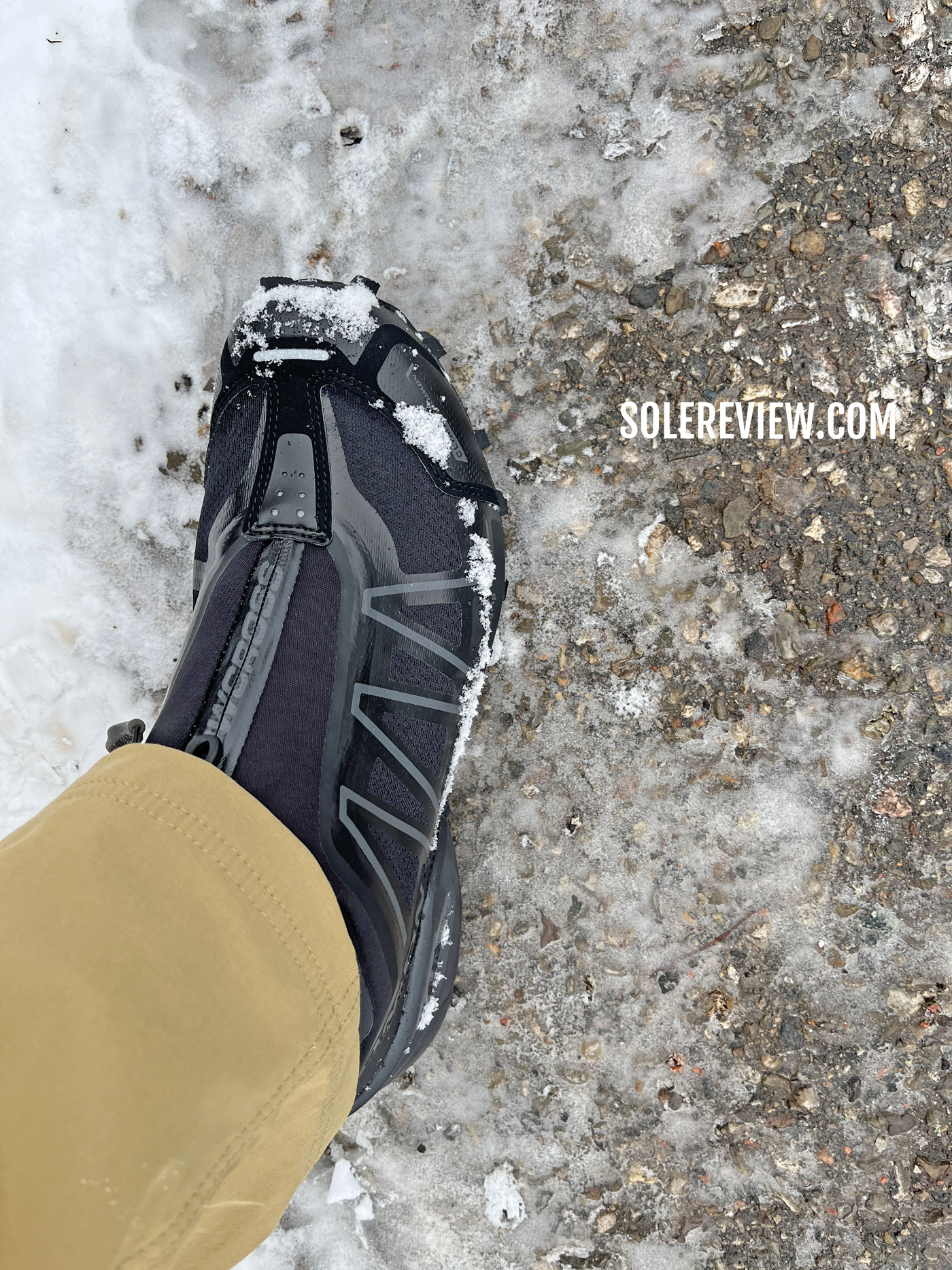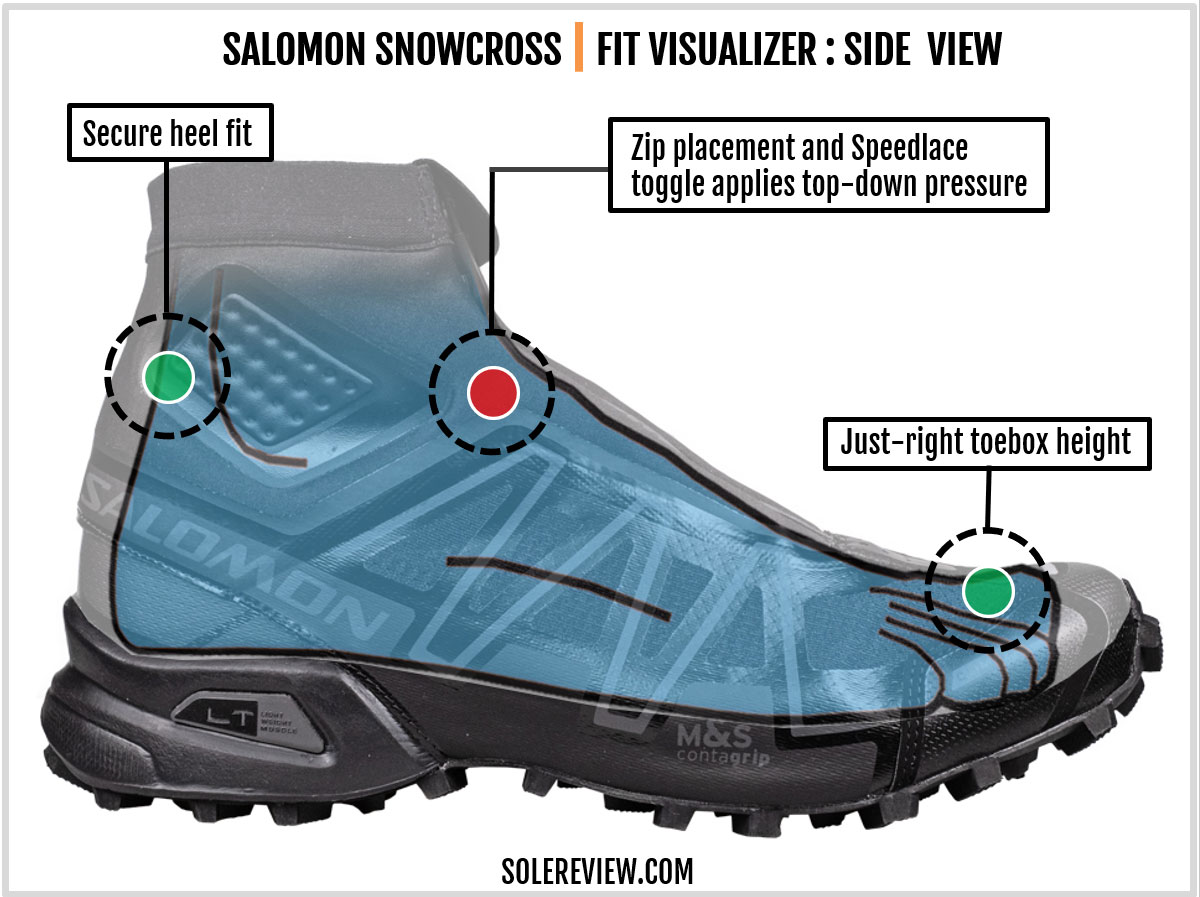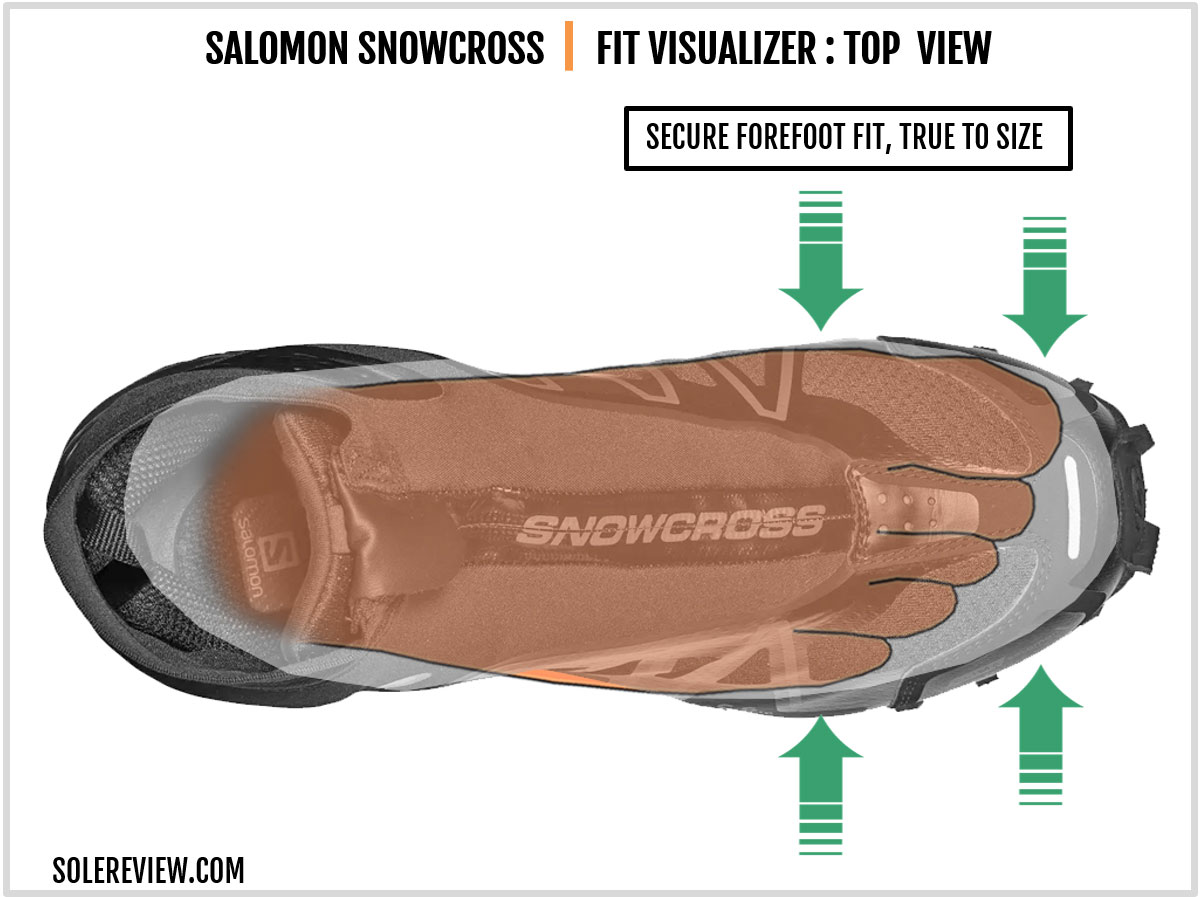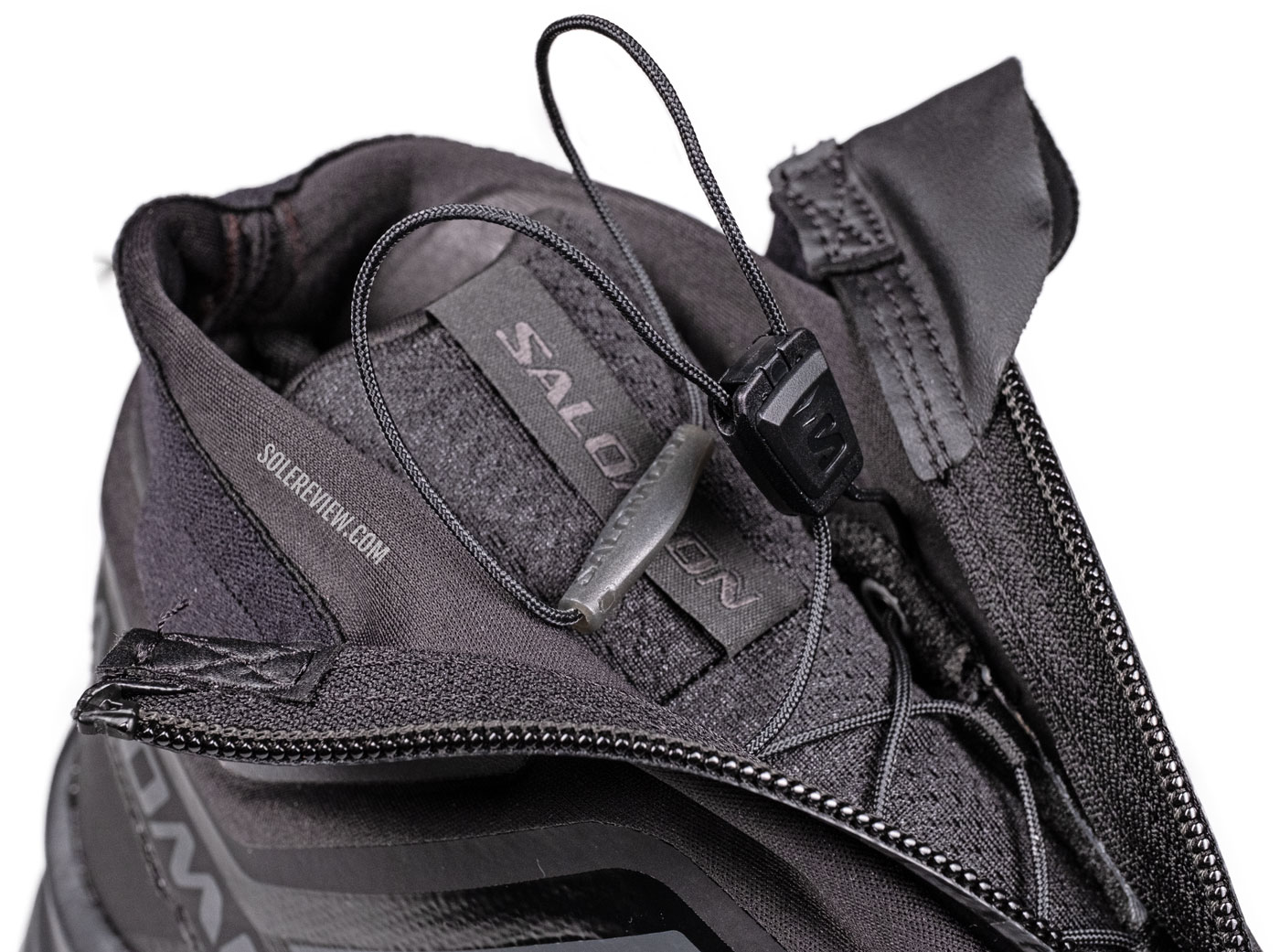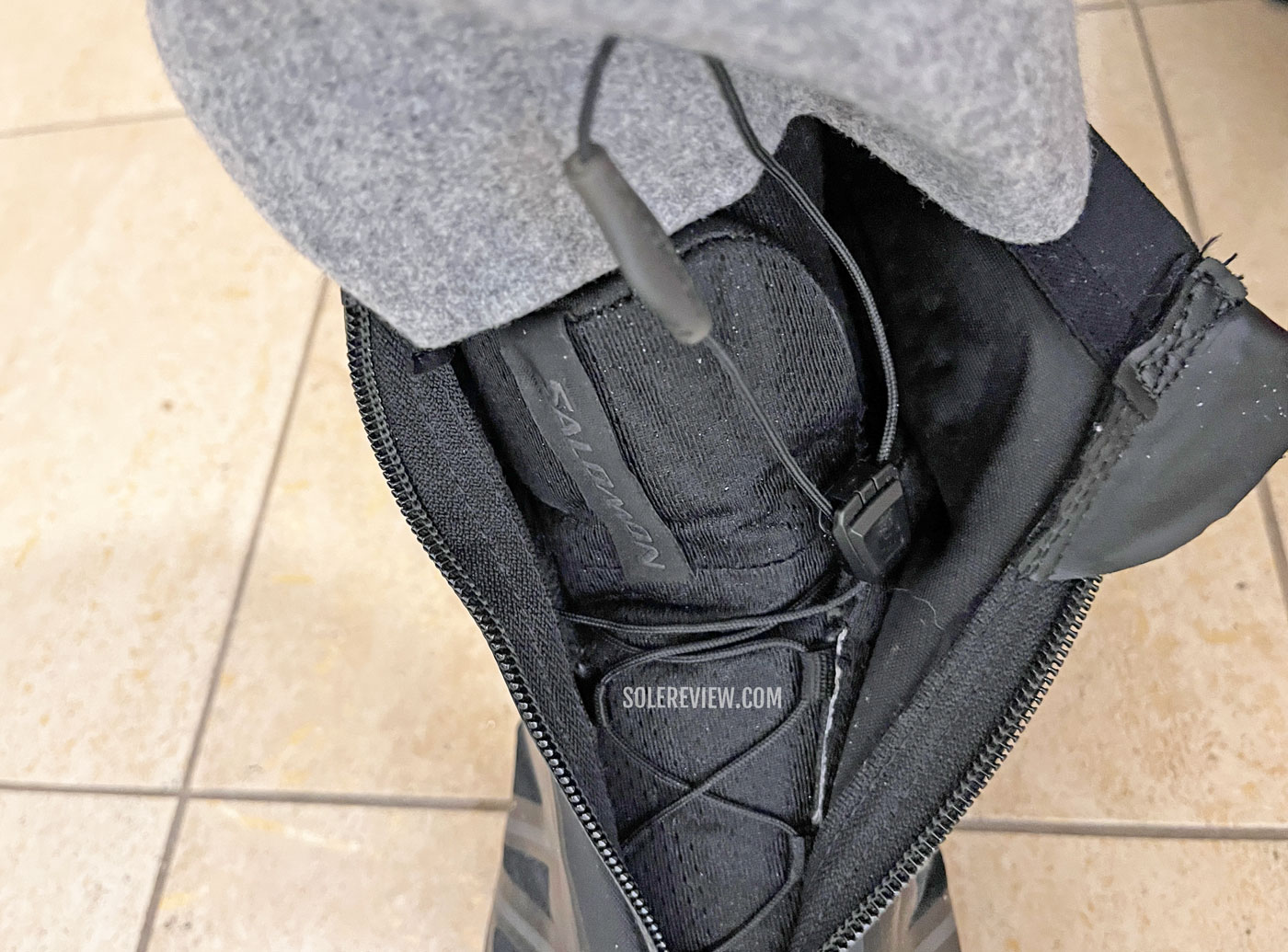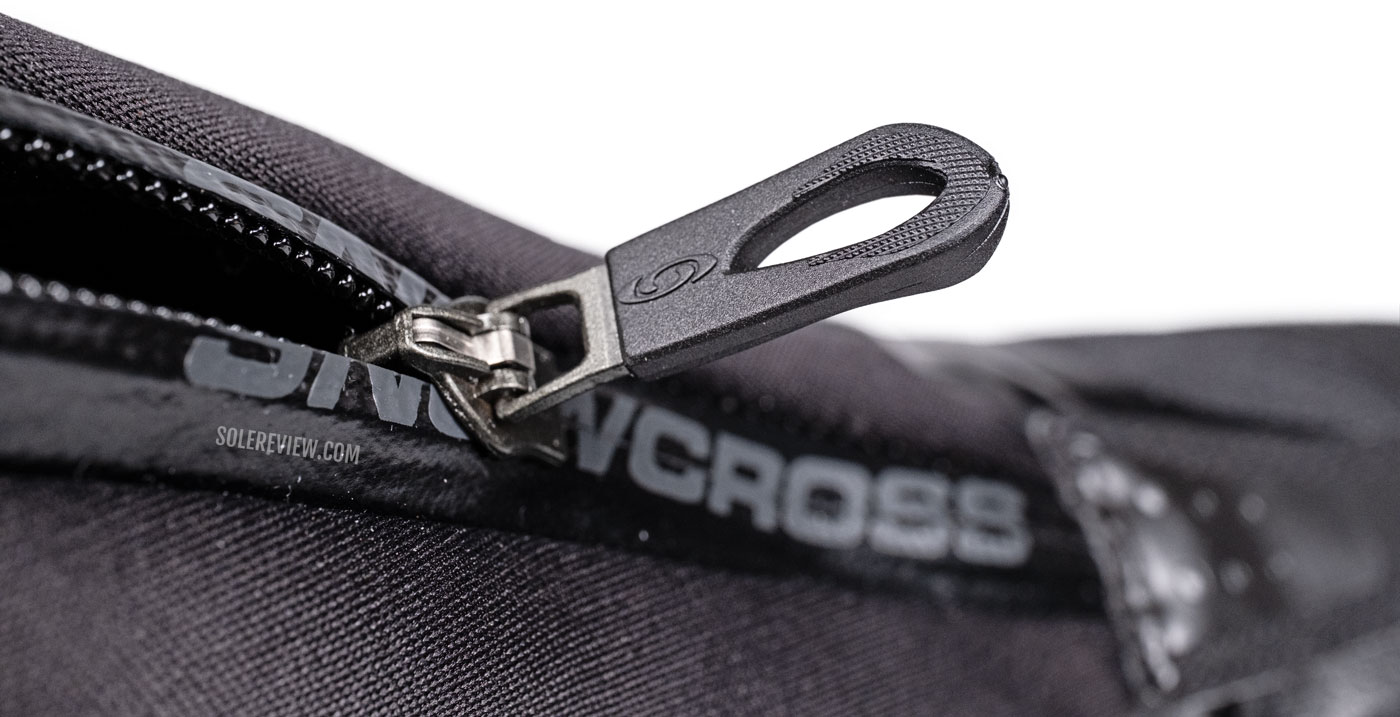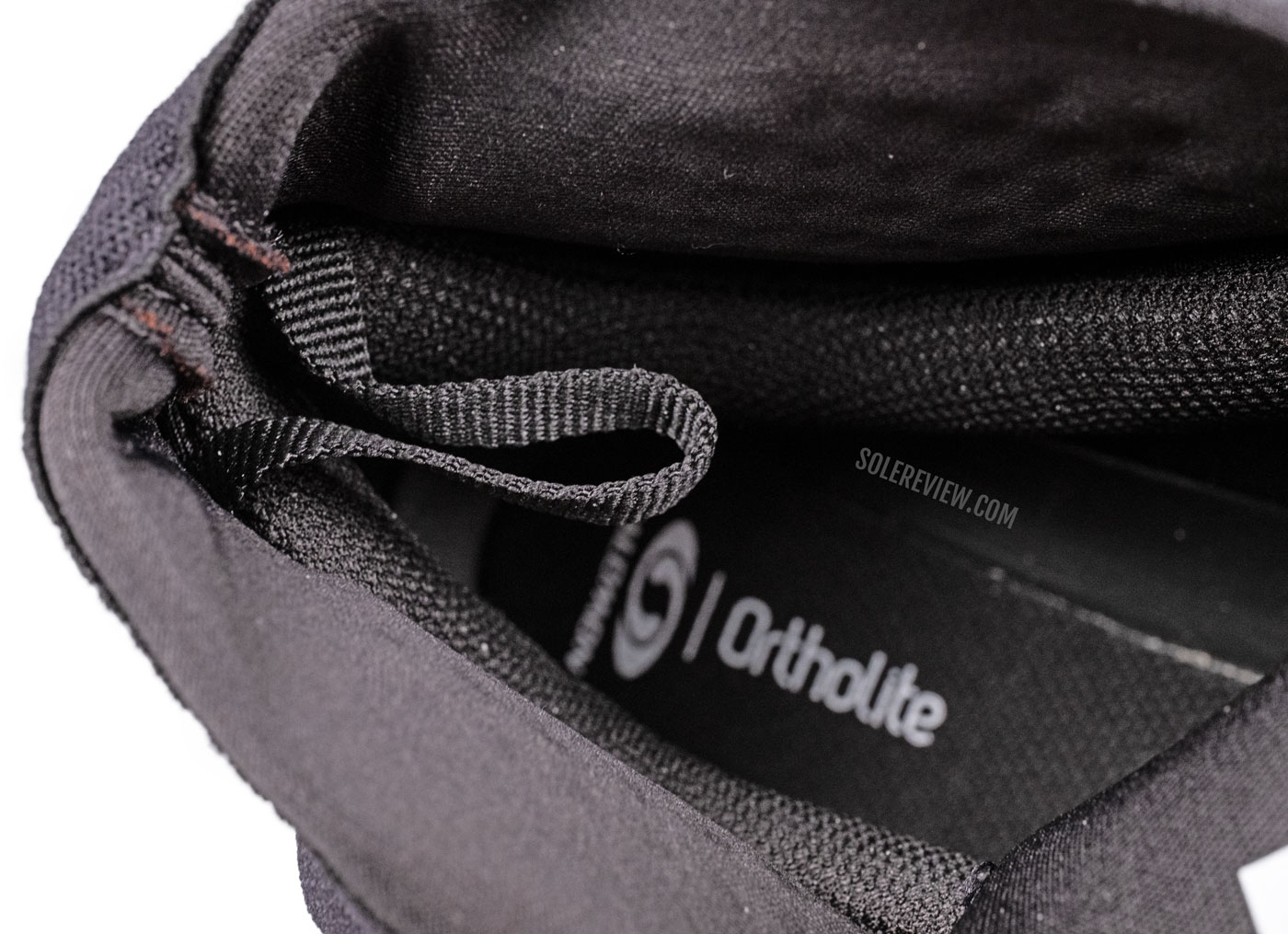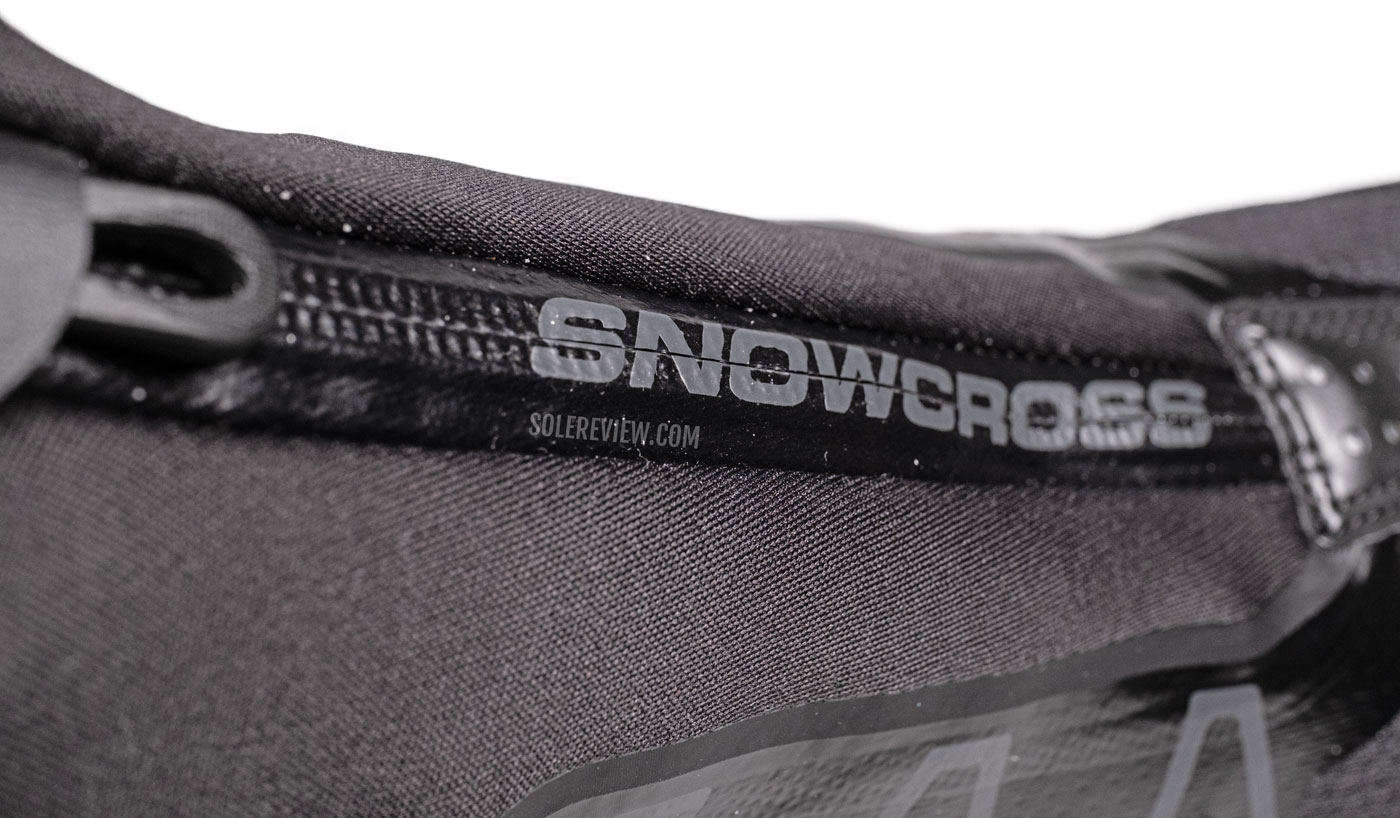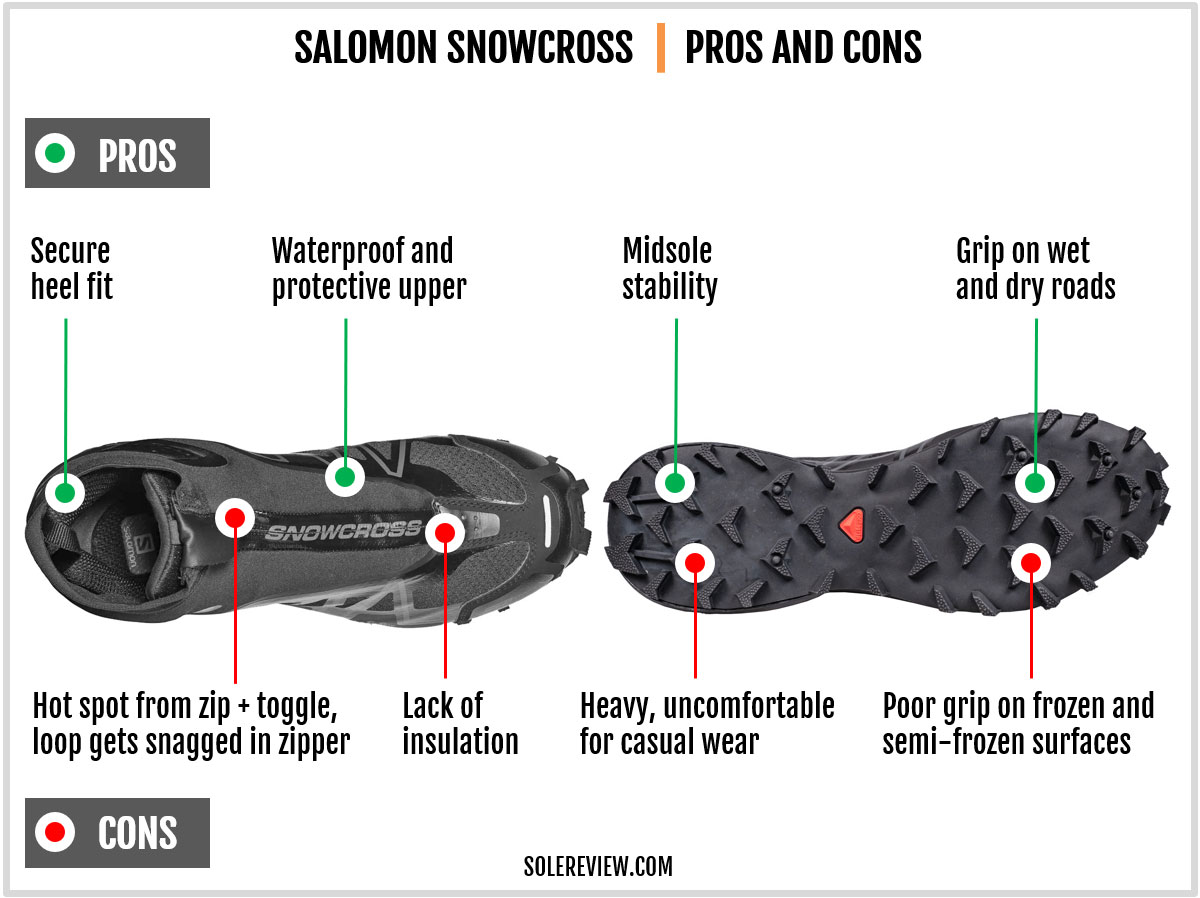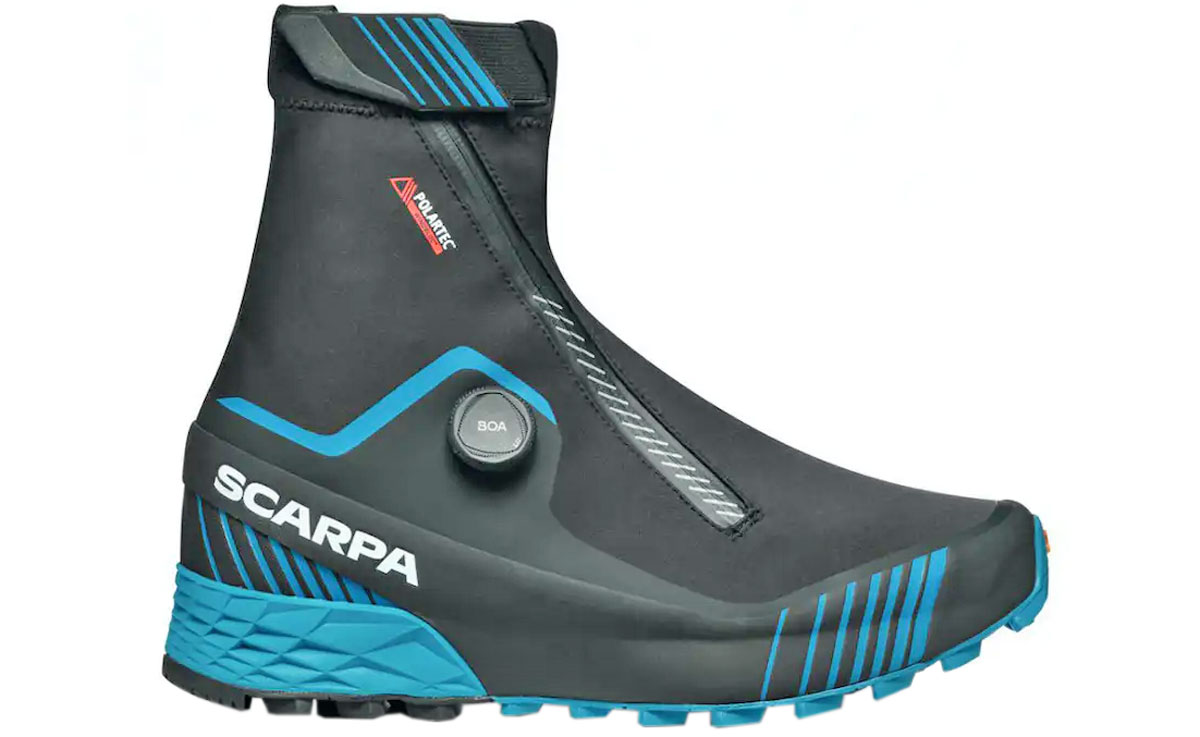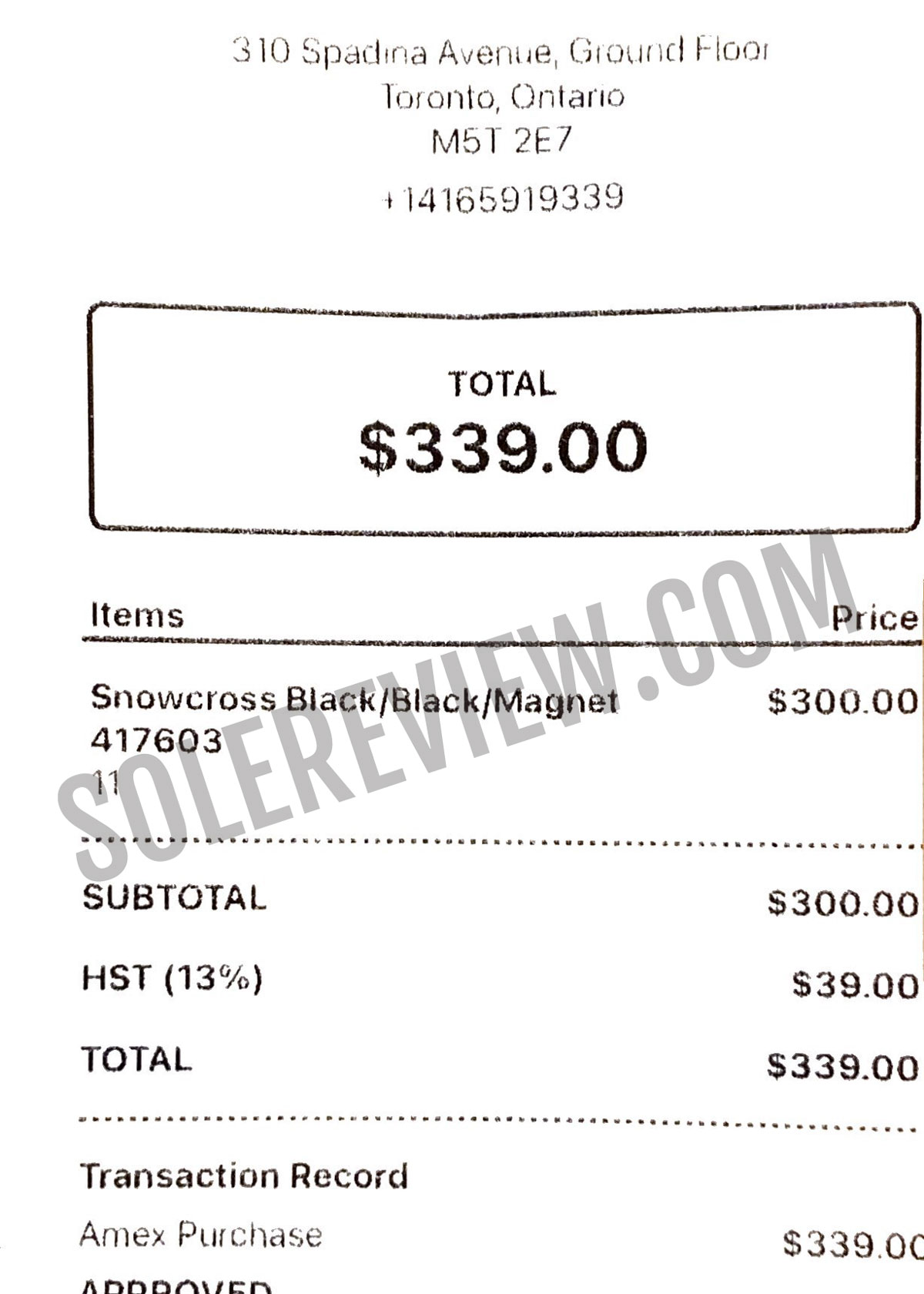
For this review, Solereview paid the full retail price for the Salomon Snowcross. The amount is in Canadian Dollars.
In this review:
SUMMARY AND VERDICT
The goal of this review is to dissuade anyone who is considering the Salomon Snowcross as their winter running shoe.
To Salomon’s credit, it categorizes the Snowcross as a ‘sports lifestyle’ sneaker on its website rather than a performance trail or hiking shoe.
But then, it’s very easy to mistake the Snowcross for a performance running shoe, given its uncanny resemblance to the Speedcross 6 and also the Snowspike CSWP – a now-discontinued winter shoe that we reviewed in 2020. The decorative rubber ‘cleats’ on the outsole may also lead people to misread the Snowcross’s winter capabilities.
So what is it, then? Is the Snowcross a capable winter sneaker, if not a cold-weather running shoe? This isn’t a terrible shoe, but falls short of the performance standards that every hardcore winter footwear must meet. The upper design is flawed as well.
Salomon claims that the Snowcross ‘fulfills all the requirements for the harsh winter conditions’, but that’s a tall claim. We had the opportunity to test the Snowcross under harsh winter conditions in Canada, and it did NOT fulfill the requirements during the wear test.
The Snowcross oversells its winter-ready capabilities; it is nothing more than a Speedcross 3 with a water-resistant gaiter. Salomon uses the older Speedcross 3 tooling for its lifestyle sneakers, and that’s the platform on which Snowcross is built.
So there’s no difference in the ride quality between the Speedcross 3 and the Snowcross. The outsole is identical, with their widely-spaced rubber lugs and cosmetic rubber ‘spikes’.
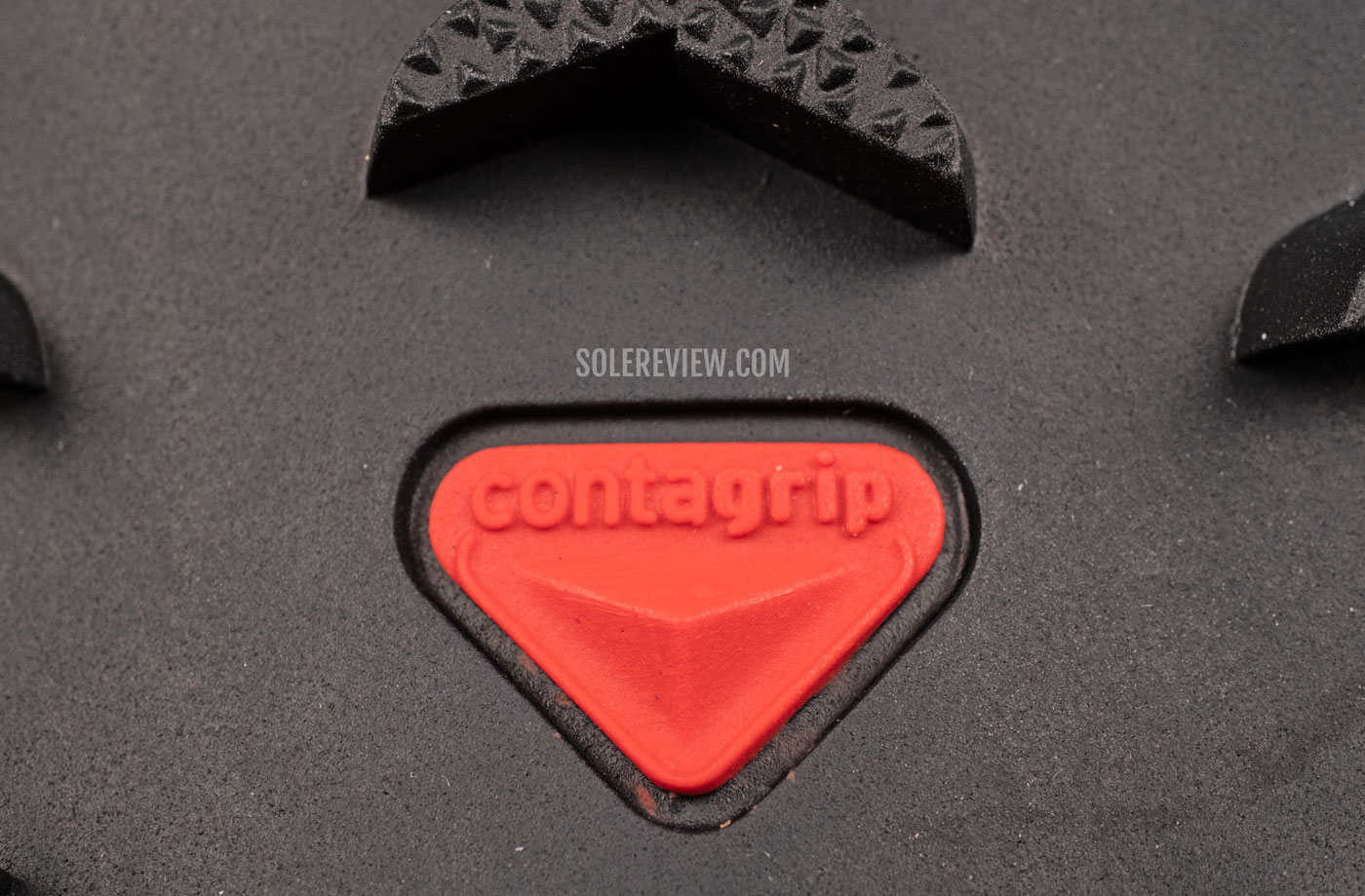
The Contagrip has excellent grip over wet and dry roads, but it’s the same as the standard Speedcross outsole. Thus, it lacks any winter-specific treatment.
The Contagrip outsole performs well on dry and wet roads, but lacks any winterized treatment – by either using a specialized compound (like adidas Continental Wintergrip, Nike Stormtread, or Vibram Arctic Grip) or lug geometry. To be clear, none of the stated examples offer a foolproof grip on ice. However, these winter compounds outperform standard outsole materials under like-to-like conditions.
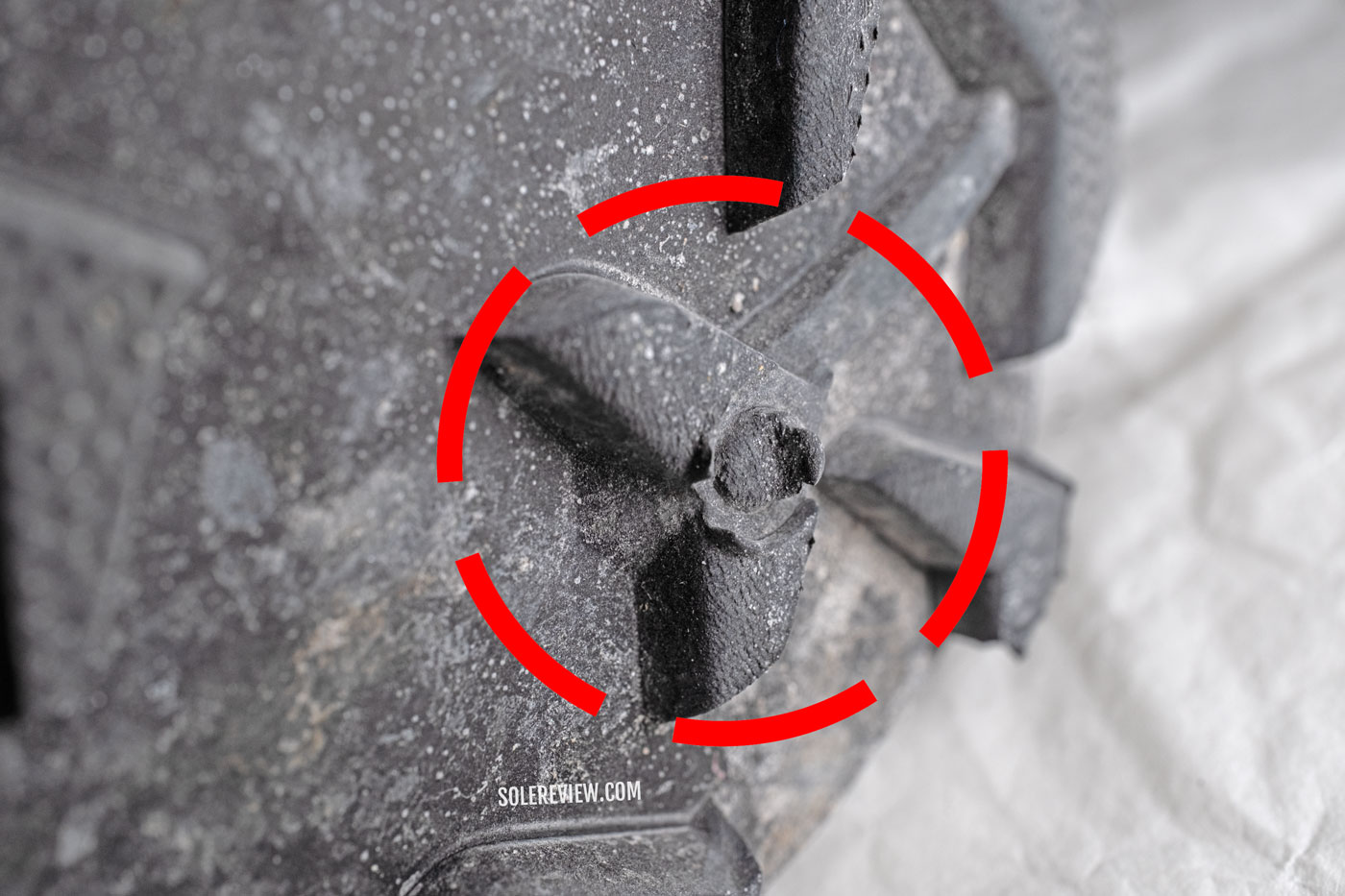
This is what happens to the ‘cleats’ after a week of wear. They are completely worn down to the base.
The decorative rubber spikes are just that – a cosmetic frill that offers no benefit over snow or ice. The decorative ‘spikes’ wear down very quickly, and in our case, one of the rubber cleats decided to take some time off from the outsole.
The outsole slips on icy patches because of its wide lug spacing, the limited contact area of the individual lugs, non-winterized rubber, and the aggressive forefoot rocker that doesn’t allow the midsole to splay wide.
Rather than Snowcross, ‘Speedcross 3 Hi’ or ‘Speedcross 3 Rain’ would be a more apt name for this shoe. At best, this is a low-tier winter shoe that doesn’t offer any advantage over, say, a Gore-Tex Speedcross. Sure, there’s a water-resistant gaiter. But there’s much more to a proper winter sneaker than mere waterproofing.
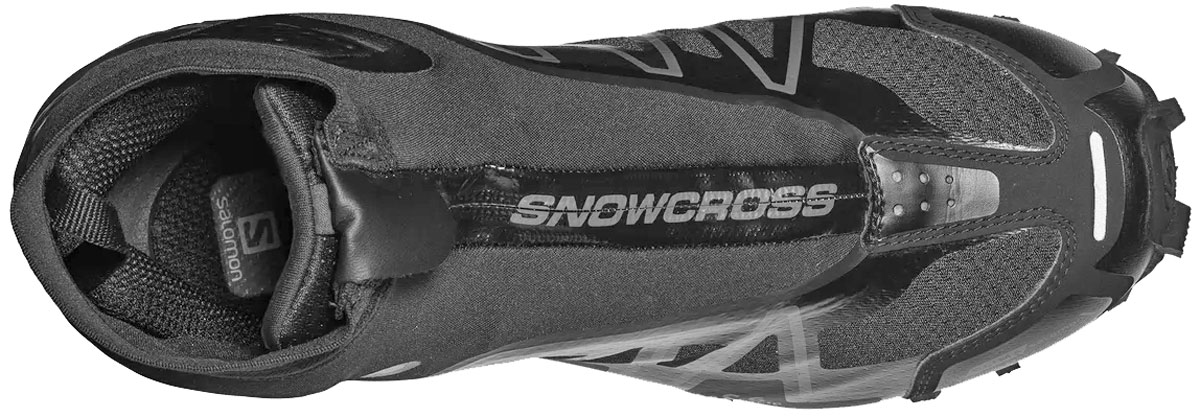
For reasons unknown, Salomon places the zip in the center – a design choice that causes various niggling issues.
Most ankle-high shoes that use a zip shroud/gaiter do so in an asymmetric fashion. So it’s surprising to see Salomon abandon that best practice on the Snowcross and place a zip right on top of the foot.
We’ll cover this at length in our upper fit section, but this placement makes the Snowcross uncomfortable when worn as intended. There is a workaround that makes the Snowcross wearable, but one shouldn’t have to do this on a $260 shoe. There’s another disadvantage of the zip; the fabric loop over the tongue gets caught in the zipper.
This is sloppy designing, to say the least.
Unless someone is a fan of the Speedcross aesthetics, the $260 Snowcross doesn’t make a strong case for a winter shoe. The Snowcross comes across as a low-effort attempt from Salomon, a shoe that was hurriedly cooked up without giving much consideration to what matters in a shoe meant for severe winter.
If the Snowcross is an underwhelming winter sneaker, what are the full-zip alternatives?
You can jump to the relevant section in our review here, but here’s a quick list – the adidas Terrex Free Hiker 2, Merrell 1TRL Agility Peak 5 Zero, and Scarpa Ribelle Run Kalibra G. Only the Scarpa and Merrell are legitimate running shoes; the adidas Terrex is a sports-lifestyle sneaker – just like the Snowcross, but more comfortable. Our performance pick is the Scarpa, followed by adidas as a winter sneaker.
THE MIDSOLE DESIGN AND RIDE EXPERIENCE
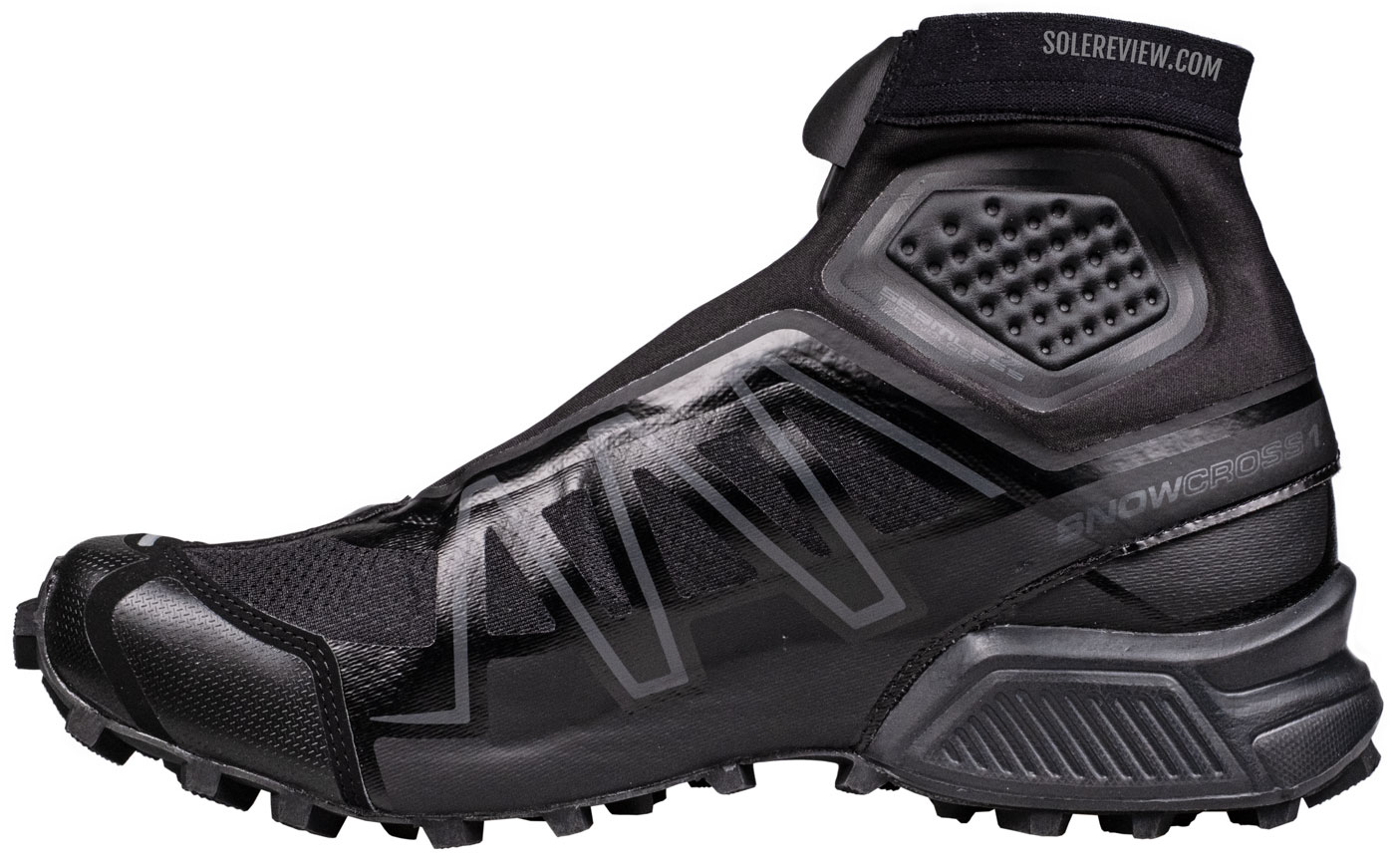
The Snowcross is based on the Speedcross 3’s double-lasted upper with its concealed forefoot midsole.
The Snowcross is built on the Speedcross 3 platform, but it’s not dissimilar to how the newest Speedcross 6 feels.
The midsole cushioning is firm, no matter how one chooses to load it. The Snowcross has the ‘double-lasted’ form factor, meaning that the forefoot midsole is ‘lasted’ over by the upper. Not many brands choose to double-last their shoes because of the manufacturing complexity, but this method has tangible benefits.
A double-lasted construction does a better job of securing the foot over the midsole without increasing the outsole footprint.
This unique design prevents the foot from sliding off the midsole edges; it also makes the foot-to-midsole power delivery efficient. The Speedcross platform offers a distinct ‘planted’ feel that very few others can replicate.
If the Snowcross is firm under the forefoot, it’s firm under the heel as well. Unlike the forefoot, the heel midsole isn’t covered with the upper. The firm EVA frame adds plenty of functional stability.
Despite the non-full contact outsole (the midfoot section is elevated), the Snowcross’s overall stability is excellent. The 12.5-ounce (354-gram) weight also gives it a sense of reassuring robustness.
Cushioning softness is available in the form of the dual-density Ortholite footbed.
The forefoot insole has a single layer of blown foam, whereas the midfoot and heel have a second layer of EVA foam. This part also doubles as the arch support or ‘arch cookie’. The Speedcross midsole has one of the most aggressive arch fits in the industry, so it’s the same for the Snowcross.
Salomon ‘adopted’ the Speedcross 3 midsole for its sports-lifestyle sneaker assortment without making any changes, so the Snowcross is nowhere as comfortable as your typical lifestyle sneaker. The midsole foam isn’t soft, while the aggressive rocker and arch fit are a reminder of the Snowcross’s performance DNA.
One could argue that ‘Gorpcore’ or ‘utility’ sneakers aren’t your average lifestyle shoes with comfort to match. That being said, newer Gorpcore entrants like the Norda 001 are great examples of everyday comfort packaged within a tough exterior.
The Snowcross’s ride doesn’t feel wooden, but is lacking in comfort when walking or standing for more than an hour.
Salomon advertises the Snowcross as a ‘shoe designed for harsh winters’, so how do the midsole and outsole perform during real winter?
We were able to test the Snowcross during snow, rain, and a cold snap, so that’s as harsh as it gets. The results were not what we’d hoped for, as the Snowcross has no real winter advantage over a standard Speedcross without a gaiter.
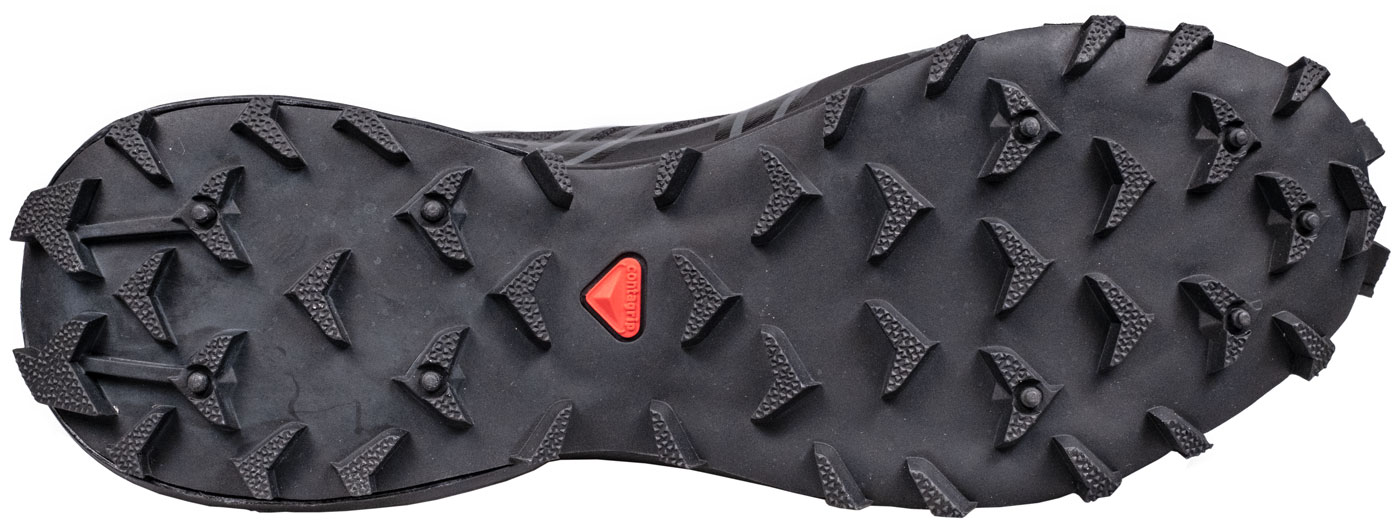
Except for slick metal storm covers, the Contagrip outsole’s grip on wet and dry roads is excellent.
Salomon’s Contagrip outsole has excellent traction over dry and wet surfaces (except for metal grates and drain covers), but struggles to find its footing in more severe conditions. Sure, if it’s just wet slush or fresh snow on the road, the Snowcross doesn’t complain. As long as the long lugs have something to bite into, you’ll have no problems with traction.
However, frozen surfaces are a different matter. The Contagrip outsole doesn’t use winter-specific formulation, nor does it offer an adequate contact area. Not only are the outsole lugs spaced very wide, the individual lugs also have sparse contact areas. The Snowspike had a similar design, except for a major difference – the lugs were reinforced with cleats.
The Snowcross doesn’t benefit from spike-equipped lugs, and is slippery over ice. The cosmetic rubber ‘cleats’ are functionally useless and wear down after just a few days of use.
Anyone who’s lived a winter to two knows that snow never stays snow. Eventually, the snow will pack into lumps of ice, and that’s where the Snowcross struggles. We’re not even talking about black ice, but those small icy patches that are commonplace during a typical winter.
The absence of thermal retention and insulation is another area where the Snowcross comes up short. At -10° C/14° F and below, the cold transmits through the midsole. The Snowcross lacks an insulating barrier like a thermal insole, so the feet get cold after walking for over 30 minutes in freezing winter.
THE UPPER DESIGN AND FIT
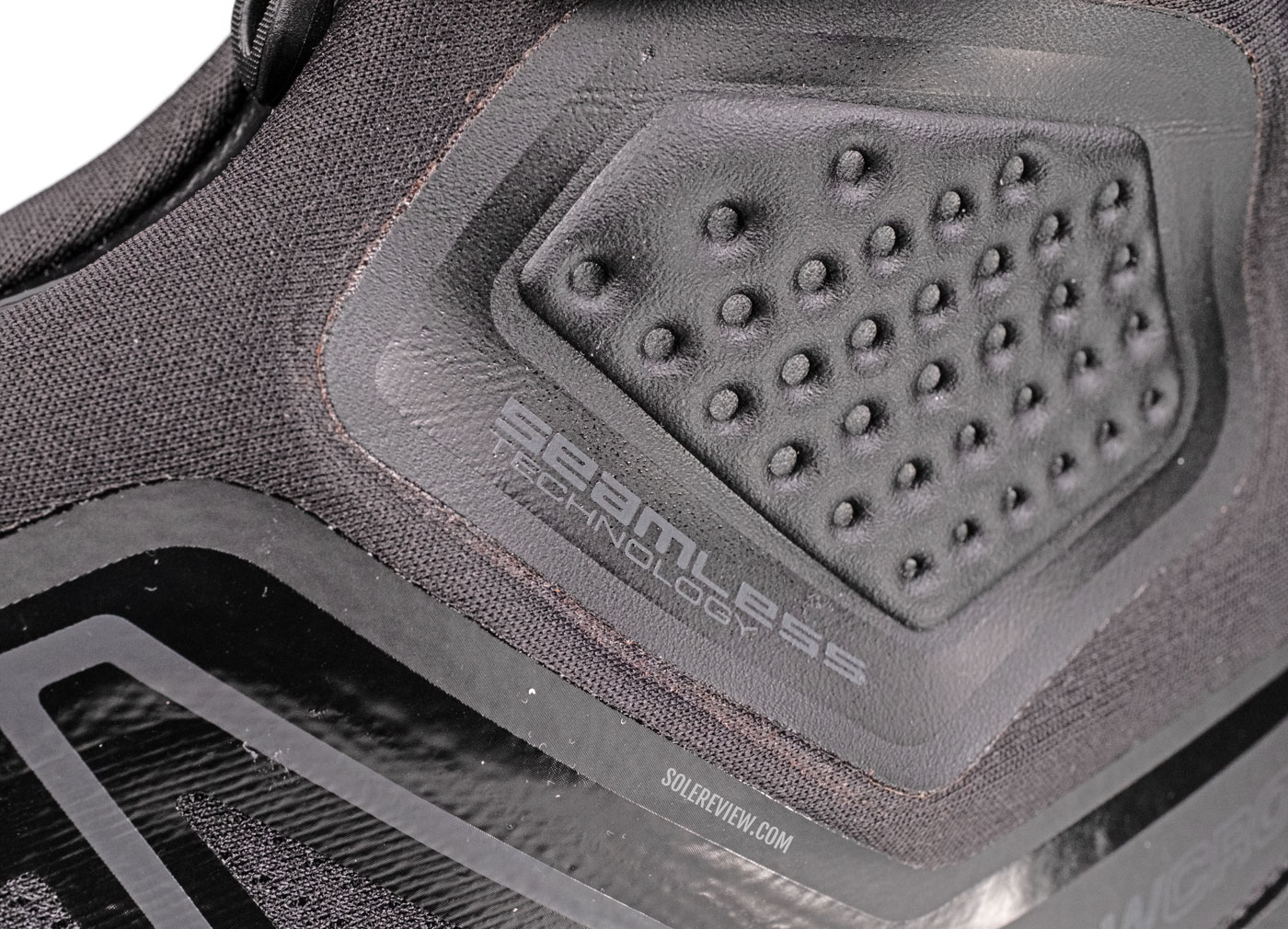
The upper uses high-frequency-welded panels to achieve a compact form without compromising protection.
The Salomon Snowcross fits like how most Speedcross shoes do – true to size and very secure. The fused upper feels very protective. The internal toe stiffener and rubber bumper help too – which happens to be an extension of the outsole. The stiff heel counter works in tandem with the midsole cup to stabilize the foot.
The fused construction also makes it very easy to wipe clean.
Though the Snowcross has an aggressive arch fit that is typical of Speedcross-based uppers, the rest of the shoe isn’t overly tight. The gaiter-covered upper does produce a ‘boxed-in’ fit, accentuated by the zip closure that pulls up the upper with a higher pressure than comparable uppers with an asymmetrical zip.
The Snowcross’s fit is like a Speedcross with a tighter midfoot and instep. The zip ‘contains’ the inner shoe within the shroud, and limits the downwards movement of the arch. This behavior ends up being too much of a good thing, and it’s hard to shake off the sense of aggressive arch support.
It is not recommended to wear the Snowcross barefoot or even with a pair of thin socks. A medium-thick wool sock dulls the arch pressure without making the fit too narrow.
There’s a good reason why full zips on a shroud or gaiter are placed asymmetrically. An off-center placement alleviates pressure by staying out of the instep flexing zone. A skewed design also makes the upper easier to zip.
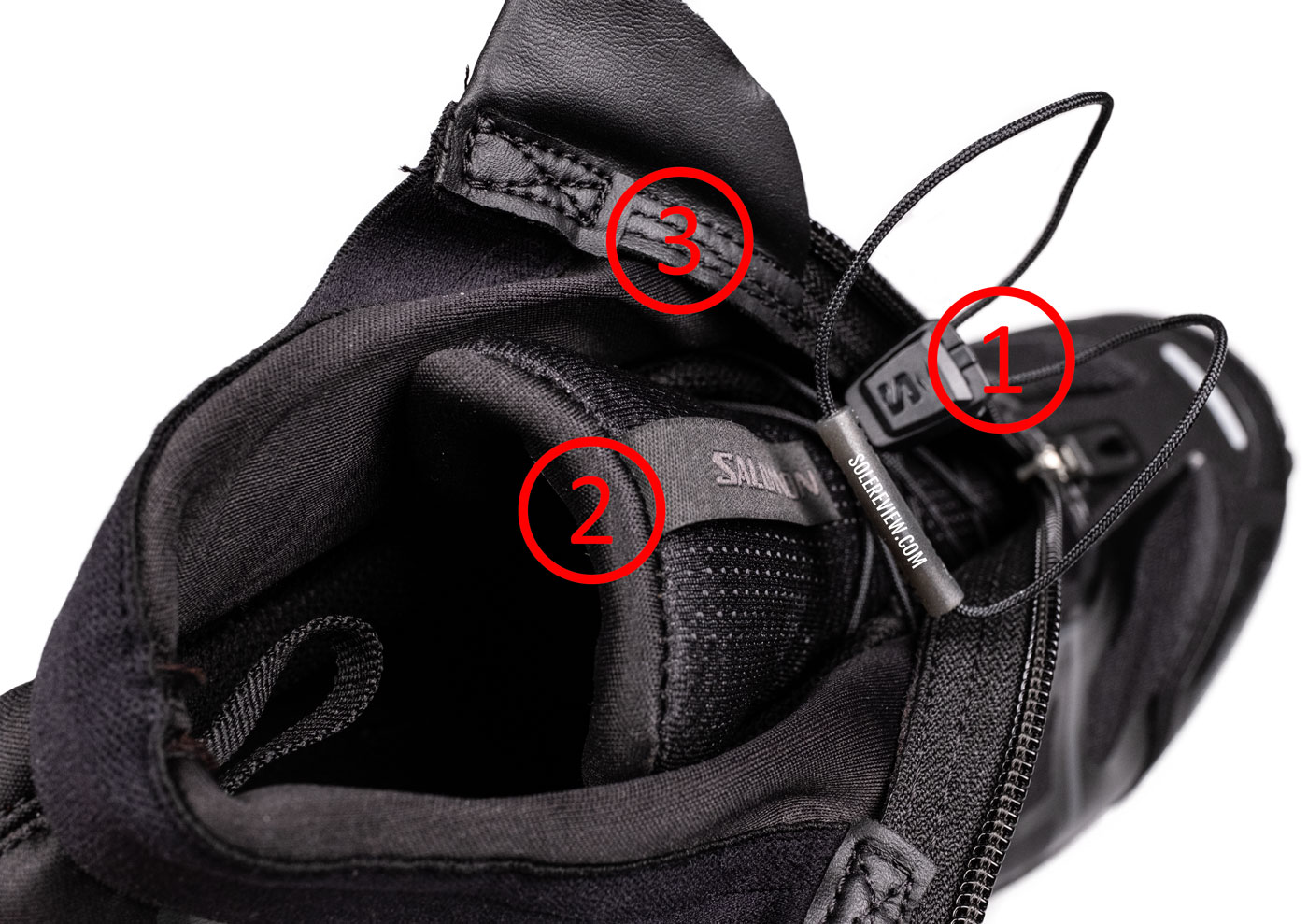
The overcrowding of different components creates a hot spot over the foot. Pictured here are the 1) Speedlace toggle 2) Padded tongue 3) Zipper and seam.
On the Snowcross, it’s easy to see why putting the zip in the center was a bad idea. A lot is going on here; there’s the thickness of the zipper, the synthetic flap where the pull tab gets tucked in, a bulk Quicklace toggle, the tongue loop, and finally the thick tongue. Separately, these are useful features, but they are not supposed to play together in a small area.
There’s just too much material concentrated in a small area for the Snowcross to be comfortable. It is truly strange why Salomon chose this design over the Snowspike’s construction; the brand has plenty of experience with zipped gaiters.
If the Snowcross is worn as intended (with the lacing toggle placed on top of the tongue), it’s very hard to pull the zip over the shoe. And even if you managed to pull it over, the plastic toggle creates an uncomfortable bump over the instep. There’s simply no place for the plastic toggle to rest; unlike the Speedcross, the Snowcross’s tongue does not have a ‘pocket’.
The only workaround is to move the toggle to the side, as demonstrated in the picture. Even so, having the zip in the center applies pressure over the instep when flexed. It’s not uncomfortable with the toggle out of the way, but there’s a sense of tightness nonetheless.
There’s another drawback of having the zip in the center. The thin loop on the tongue gets snagged when unzipping the shoe. This happens because the zip is tight over the instep, and that’s where the loop is. This increases the chances of snagging the fabric loop.
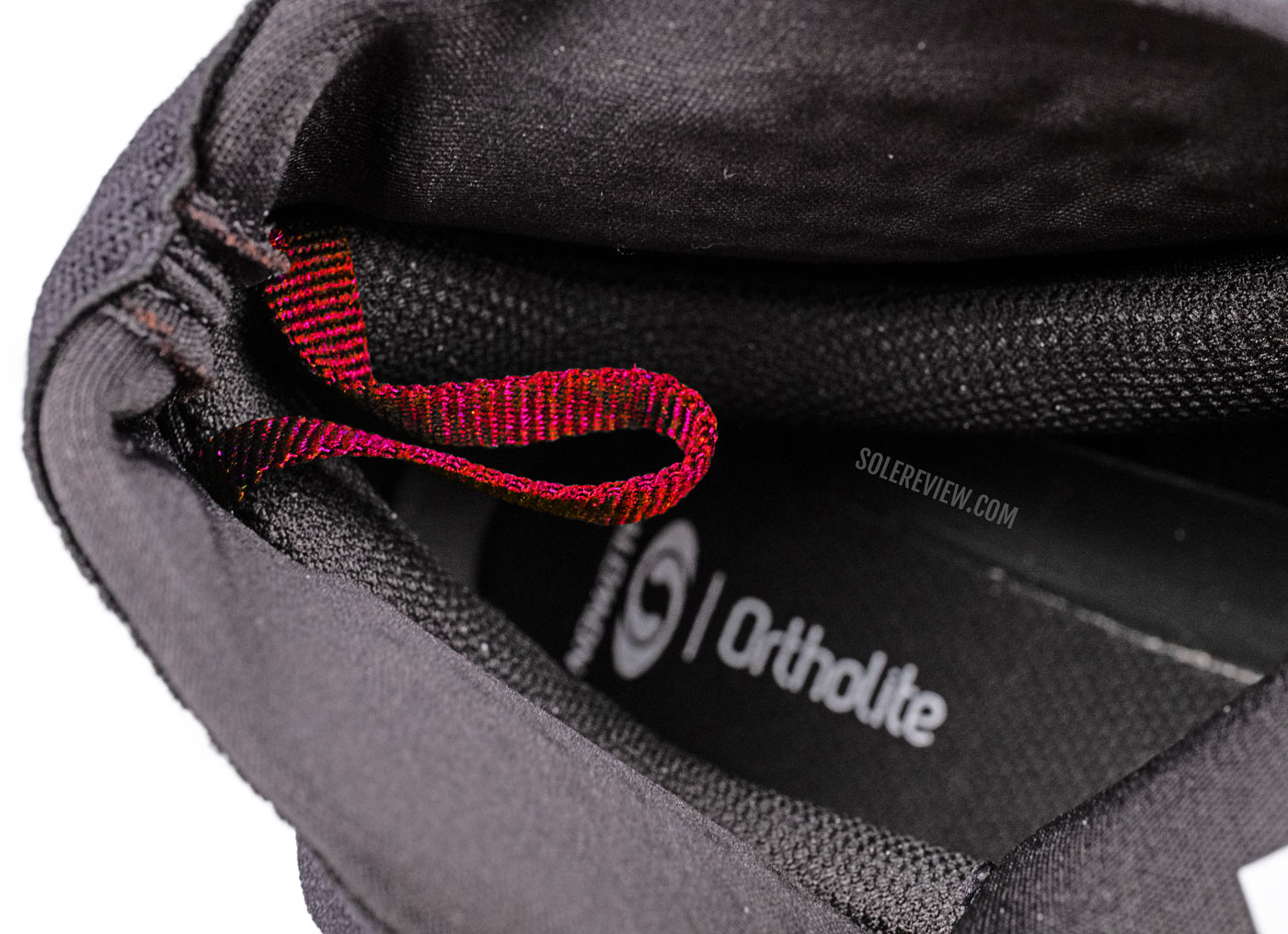
Here’s what the heel pull loop looks like (mock-up by Solereview) in a contrast color – much easier to find, no?
We’re talking about loops, so there’s one over the heel too. It’s useful as long as you can find it – the black loop is lost within the sea of black. It’s very helpful to pull the shoe over the heel, but it would have been more useful in a bright color. Here, we even changed the color to brilliant red to show you how much of a difference that makes.
And just how waterproof and insulated is the Snowcross? Unlike most winter-oriented footwear, the upper has no insulating features. For example, the insides do not have a fleece lining (like on the Pegasus Shield) nor technologies like PolarTec. (which the Scarpa Ribelle has)
The feet get cold when in temperatures lower than -10° C/14° F. The shroud does a good job of blocking the wind and rain, but does very little for insulation and heat retention.
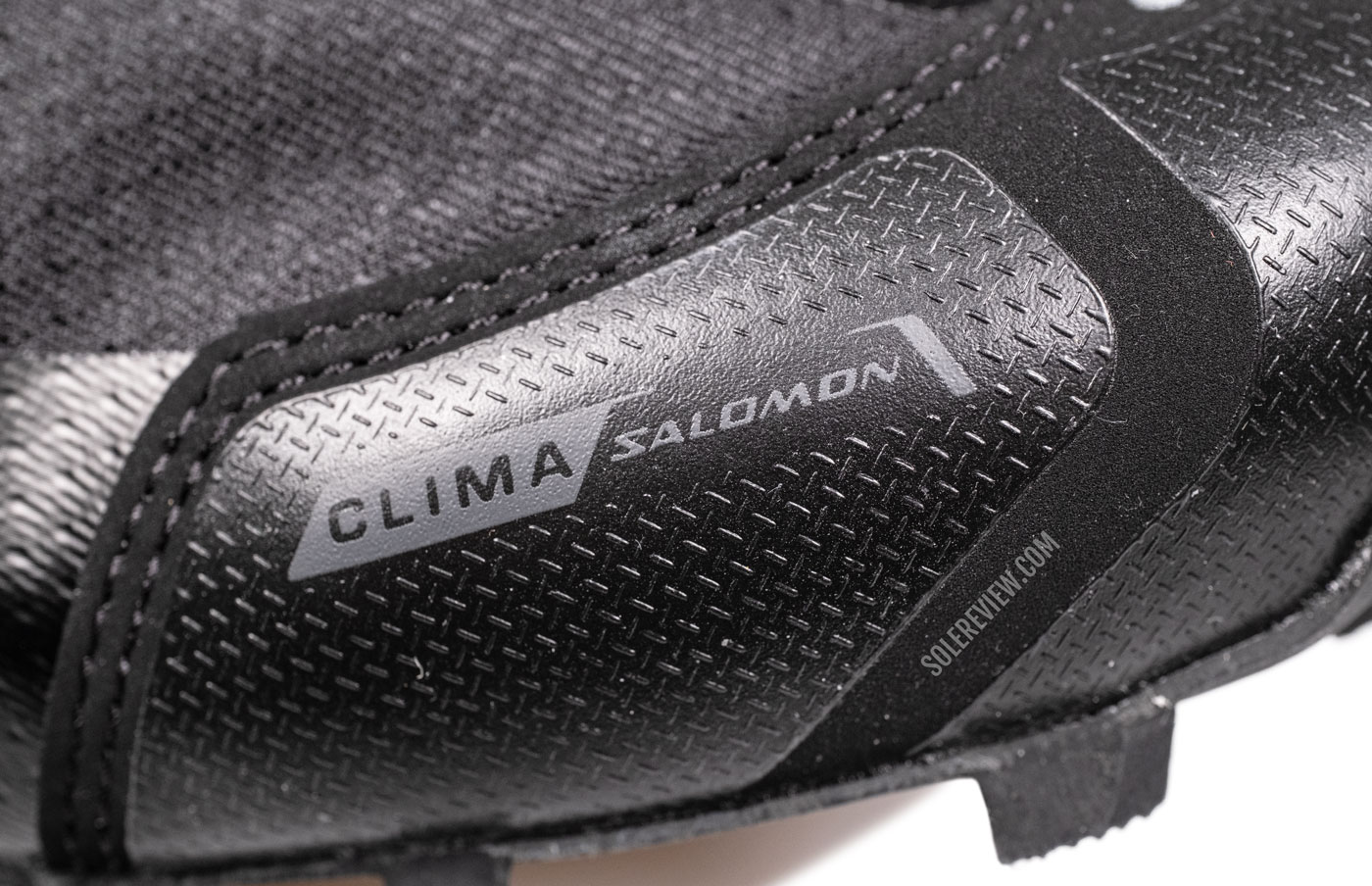
While not 100% waterproof, the ClimaSalomon upper keeps the feet dry during rain showers and over slushy terrain.
The ClimaSalomon upper won’t stop the water from entering if the shoe is submerged over the base of the zipper. While the zipper has weather-resistant flaps, there’s a limit to its water resistance.
On the other hand, the Snowcross keeps the feet dry during rain showers and inclement weather. You could walk around in the Snowcross for an hour in the rain and not have to worry about getting your feet wet.
Low-light visibility is another area where the Snowcross is average. Only the toe-box is slightly reflective; for a sneaker that is advertised for ‘harsh’ winter conditions, high-viz elements should be a higher design priority.
ORTHOTIC COMPATIBILITY
The Salomon Snowcross has low compatibility with orthotics. The thin stock insole and aggressive midfoot fit do not leave much margin for error; inserting an insole with a different dimension will alter the fit.
Also, the stock Ortholite footbed is the layer that adds cushioning softness over the firm midsole. Replacing that with a stiffer orthotic will lead to a noticeable decrease in ride comfort.
PROS AND CONS
A stable ride and secure fit have been the hallmarks of the Speedcross form factor, and the Snowcross is no different.
Despite its slim footprint, the firm midsole has a very planted ride. The double-lasted upper helps too; the upper wraps the forefoot midsole and locks the foot down over the midsole.
As long as you’re not submerging the Snowcross in streams, the waterproofing is good enough for rain showers. The outsole traction is excellent over dry and wet roads, except for metal grates and storm drain covers.
Where the Snowcross comes up short are its winter-ready capabilities and imperfect upper design. The outsole grip is slippery over ice against comparable (non-cleated) rubber outsoles, and the symmetrical zip over the shroud causes discomfort unless you move the toggle out of the way.
The arch fit is too aggressive for a lifestyle sneaker; Salomon hasn’t made any retrofits (to the Speedcross 3 design) to make the Snowcross more friendly for the casual wearer.
SHOES COMPARABLE TO THE SALOMON SNOWCROSS
If your goal is to find a winter running shoe with a zipped shroud, the Scarpa Ribelle Run Kalibra G should be your first pick. It’s like a performance version of the Snowcross that offers a polished experience at a $20 cheaper price.
Not only is the water-resistant gaiter taller, but the zip is located on the side – as it should be. The BOA cord system solves the problem of toggles while making it easier to operate with gloved hands. The upper uses wind-blocking Polartec for weather protection, and the deep outsole lugs are formulated for winter conditions.
Like the Snowcross, the double-lasted construction produces a planted ride.
The adidas Terrex Free Hiker 2 C.RDY (short for Cold Ready) is the best all-around winter sneaker with a zipped shroud. This shoe delivers the proven reliability and comfort of the Boost midsole and Continental rubber outsole. The gaiter/shroud is made of waterproof Gore-Tex.
Buying the Merrell 1TRL Agility Peak 5 Zero gets you a more comfortable shoe with a zipper shroud. The upper is waterproof too, thanks to the Gore-Tex membrane. While the inner shoe has a toggle, the asymmetrical zip placement alleviates the pressure.
The Agility Peak Zero is more versatile than the Snowcross. Features like the Vibram Megagrip outsole and EVA midsole provide sufficient grip and ride comfort for hikes, short runs, and everyday casual use. The upper is also spacious enough for winter socks.
For running on icy surfaces, any cleated running shoe will do. Our detailed buyer’s guide is here, but if you want a quick recommendation, the Salomon Winter Cross spike is a safe pick.
Do you own this shoe? Improve this review by sharing your insights.

